Chimpanzee Trekking in Uganda – A Complete Guide
[ad_1]
Are you planning a trip to go chimpanzee trekking in Uganda? Or perhaps you are just generally interested in learning what a chimpanzee trekking experience is like.
Whichever it is, we think this guide will help you. We’ve put it together based on our experience trekking to see chimpanzees in Uganda. Along with gorilla trekking, chimp trekking is a popular activity with visitors to Uganda.
This guide will tell you everything you need to know, from where to see chimpanzees in Uganda, to how much it costs, how hard chimpanzee trekking is, what you need to bring with you, and lots more.
We’ll also describe our chimpanzee trekking experience in Kibale Forest so you have an idea of what it’s actually like. Naturally, this will all be accompanied by lots of our photos of the experience as well, and I’ll be sharing some tips on getting great photos on your trek too.
This guide is focused towards chimpanzee trekking in Uganda specifically, however many sections will apply to chimpanzee treks in other countries as well.
Where Can you see Chimpanzees in Africa?
Chimpanzees have one of the largest geographic distributions of any great ape, with territory spanning across central and western Africa; from Senegal in the west through to Tanzania and Uganda in the east.
There are currently 21 African countries which are home to wild chimpanzees: Angola, Burundi, Cameroon, Central African Republic, Republic of Congo, Democratic Republic of Congo, Côte d’Ivoire, Equatorial Guinea, Gabon, Ghana, Guinea, Guinea-Bissau, Liberia, Mali, Nigeria, Rwanda, Senegal, Sierra Leone, Sudan, Tanzania, and Uganda.
However, not all of them are necessarily safe for tourists to visit, or have chimpanzee populations that are easily accessible.
Most visitors wanting to see chimpanzees in the wild visit Uganda, Rwanda, or Tanzania. These destinations are where groups of chimpanzees have become habituated to human visitors, meaning you can get closer to the animals and have a better chance to see them with local guides.
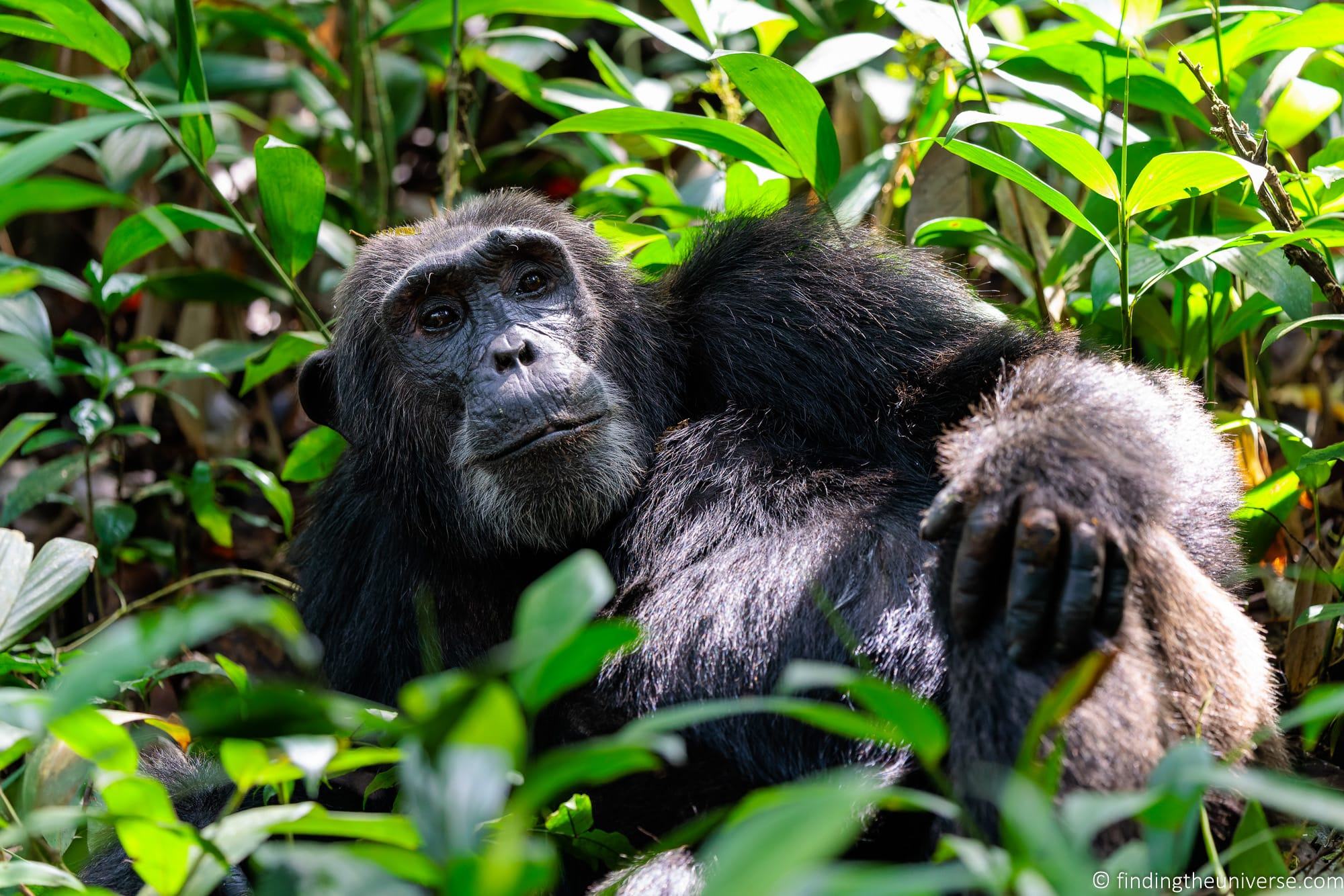
Where Can you See Chimpanzees in Uganda?
Uganda offers a number of locations where you can go chimpanzee trekking, and the country is home to over 5,000 wild chimpanzees.
There are four main locations in Uganda where you can go chimp trekking. These are:
- Kibale Forest National Park. One of the most popular places to see chimpanzees in Uganda due to the large population of chimpanzees here (over 1,500). Managed by the Uganda Wildlife Authority. There are four habituated groups here.
- Kalinzu Forest Reserve, near Queen Elizabeth National Park. Managed by the Uganda National Forest Authority, this is the lowest cost chimpanzee trekking option in Uganda. It’s home to around 300 chimpanzees, with one habituated group.
- Kyamburu Gorge, Queen Elizabeth National Park. Another good location for chimpanzee trekking in Uganda is the Queen Elizabeth National Park, and specifically Kyamburu Gorge. This is managed by the Uganda Wildlife Authority, and is priced lower than Kibale as it is less popular. There are around 30 chimpanzees here, in one habituated group. The area is fairly small so they are normally relatively easy to find, however if they retreat deep into gorge there can be a longer trek.
- Budongo Forest Reserve, near Murchison Falls National Park. Home to around 700 chimpanzees, with one habituated group. This is managed by Uganda Lodges and the Uganda National Forest Authority.
You can also see chimpanzees at the Ngamba Island Chimpanzee Sanctuary. This island is found in Lake Victoria, and is home to a number of orphaned chimpanzees. This can be reached by boat from Entebbe.
If you want a guaranteed chimp viewing experience with no trekking required, this is a good option. It’s also a good option if you are in Uganda for a short period of time, as you can visit here easily from Entebbe or Kampala.
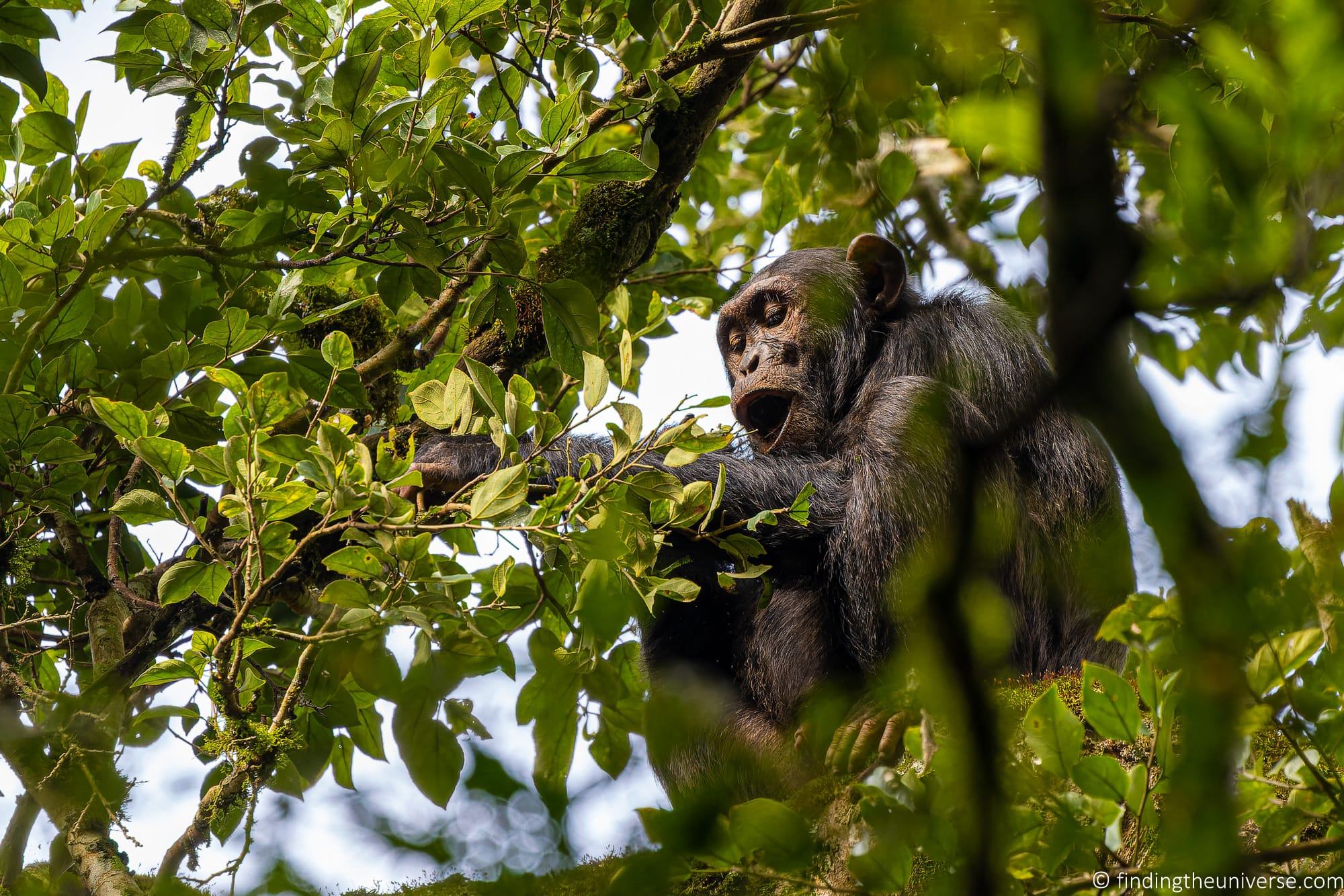
Do you Need a Permit to go Chimpanzee Trekking?
To have a good chance to see chimpanzees in Uganda, you will need to take a chimpanzee trekking tour. These tours all require some form of payment, and most also require a permit.
In the national parks which are managed by the Uganda Wildlife Authority, specifically Kibale Forest National Park and Kyamburu Gorge, you need a Chimpanzee Trekking Permit. The permit includes the cost of the chimpanzee trekking activity, guide, and briefing.
For the other locations, which are managed outside of the Uganda Wildlife Authority remit, you still need to pay for the chimpanzee trekking, but this is a guided tour payment rather than a permit specifically.
Honestly, these are all just semantics. The bottom line is that if you want to take a chimpanzee trek in Uganda, you need to book and pay to do so.
It is of course theoretically possible to see chimpanzees in Uganda without going on a tour. There is a large population in Kibale forest for example, so if you are in Kibale Forest there is a chance you might see chimpanzees while doing something else.
However, this is likely to just be a distant fleeting glimpse, so won’t quite be the same experience as a guided trek to a habituated group.
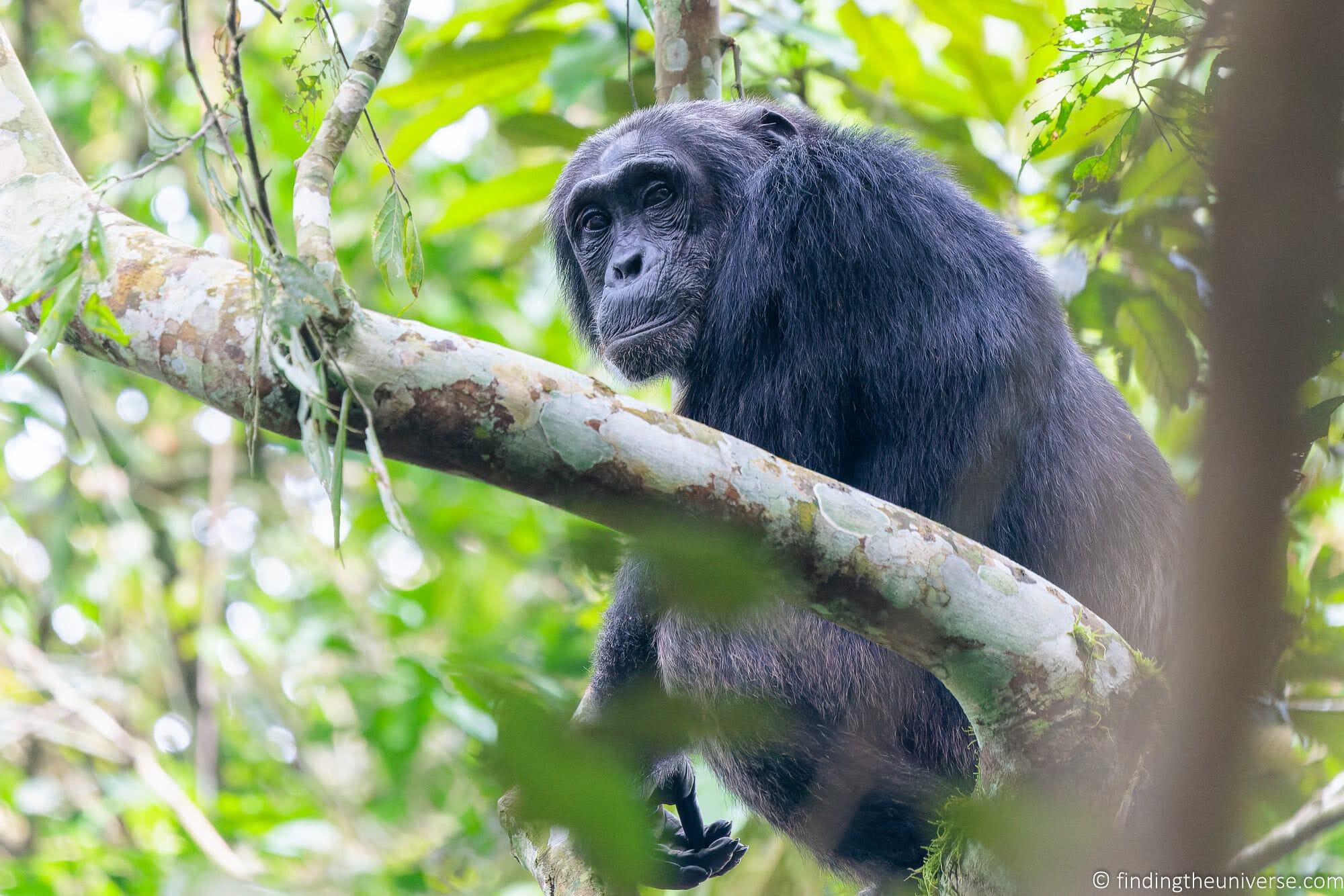
How Many People Go on a Chimpanzee Trek?
Chimpanzee trekking groups are limited to a small number, usually between six and eight people. Multiple groups can set off at the same time from the same trekking center, but they will walk separately through the forest in search of the chimpanzee groups.
If there is a large group of chimpanzees all together, then the separate trekking groups might come back together to observe the chimpanzee group. This is generally the case in Kibale.
Note group size might vary slightly depending on where you go chimpanzee trekking in Uganda, but we believe the group sizes are always under 10 people.
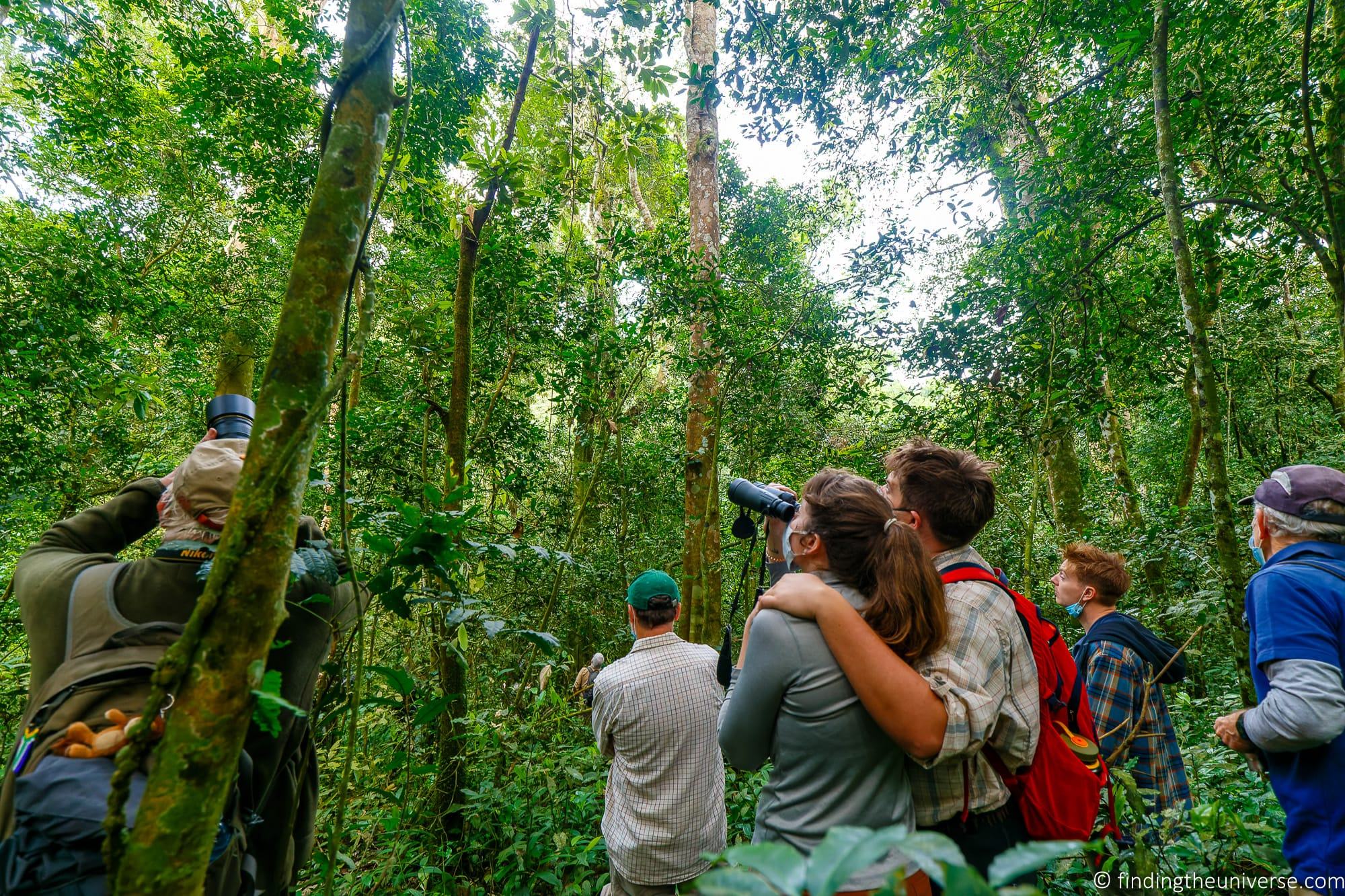
How Likely Are you to See Chimpanzees in Uganda?
If you take a chimpanzee trek in Uganda you have a very good chance to see chimpanzees. In Kibale for example, the Uganda Wildlife Authority estimates that there is around a 90% chance of seeing chimpanzees on a trek.
There is a slightly lower chance of seeing the chimpanzees in Kyambura gorge as the gorge is quite long, so if you are unlucky they might be quite far from the trek start point. However, most groups still see them.
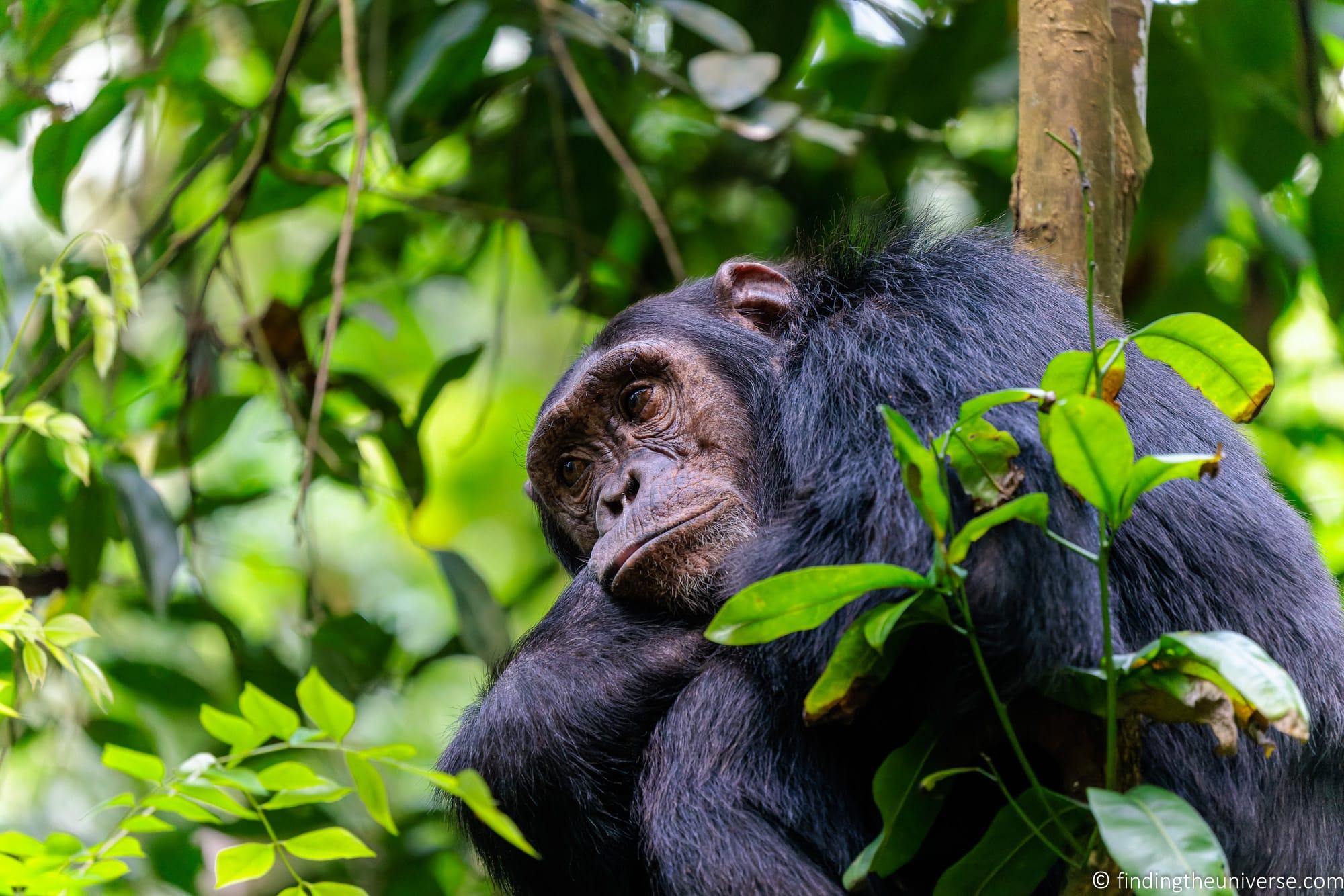
How Long Do You Spend with the Chimpanzees in Uganda?
When you have found the chimpanzee group, you will have one hour to spend with them. This is the same amount of time as you get when gorilla trekking in Uganda.
An hour should be plenty of time to see the chimpanzees, observe their behaviour, and take lots of photos. However, be aware it will feel like it goes by very quickly!
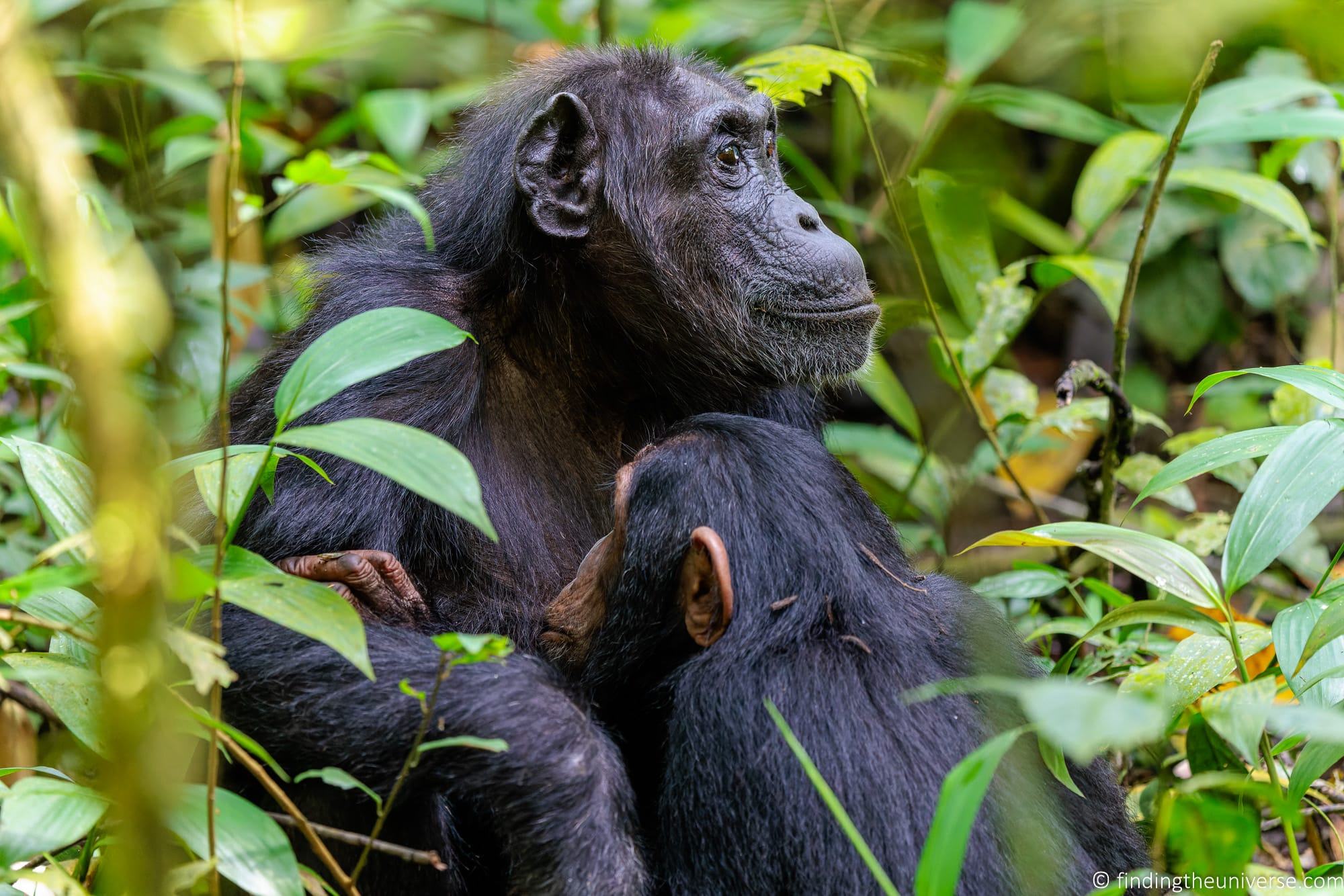
How much does it cost to go Chimpanzee Trekking in Uganda?
The cost of chimpanzee trekking in Uganda varies depending on where you go trekking, from around 50 USD to 200 USD. There can also be a difference in price depending on if you are a visitor, a foreign resident, or a Ugandan resident.
Note that the fees are normally for the chimpanzee trekking activity only. Treks take place in forest reserves or national parks, for which there is normally also a fee payable for entry.
The prices in Uganda for 2022 are as follows. These are subject to change of course, so always check the latest prices.
- Kibale Forest National Park. 200 USD for foreigners, 150 USD for resident foreigners, 150,000 UGX for East African Community Residents. This fee includes national park entry on the day. Check latest prices and book online here.
- Kyamburu Gorge, Queen Elizabeth National Park. 50 USD for foreigners and resident foreigners. 30,000 UGX East African Community Residents. Check latest prices and book online here.
- Kalinzu Forest Reserve. 50 USD. You can book in-person on site or you can call ahead. Details are on the website here.
- Budongo Forest. 120 USD / 130 USD. You can check latest prices and book online here.
- Ngamba Island. From $73 USD per person. Pricing varies depending on group size and transport option. See rates here.
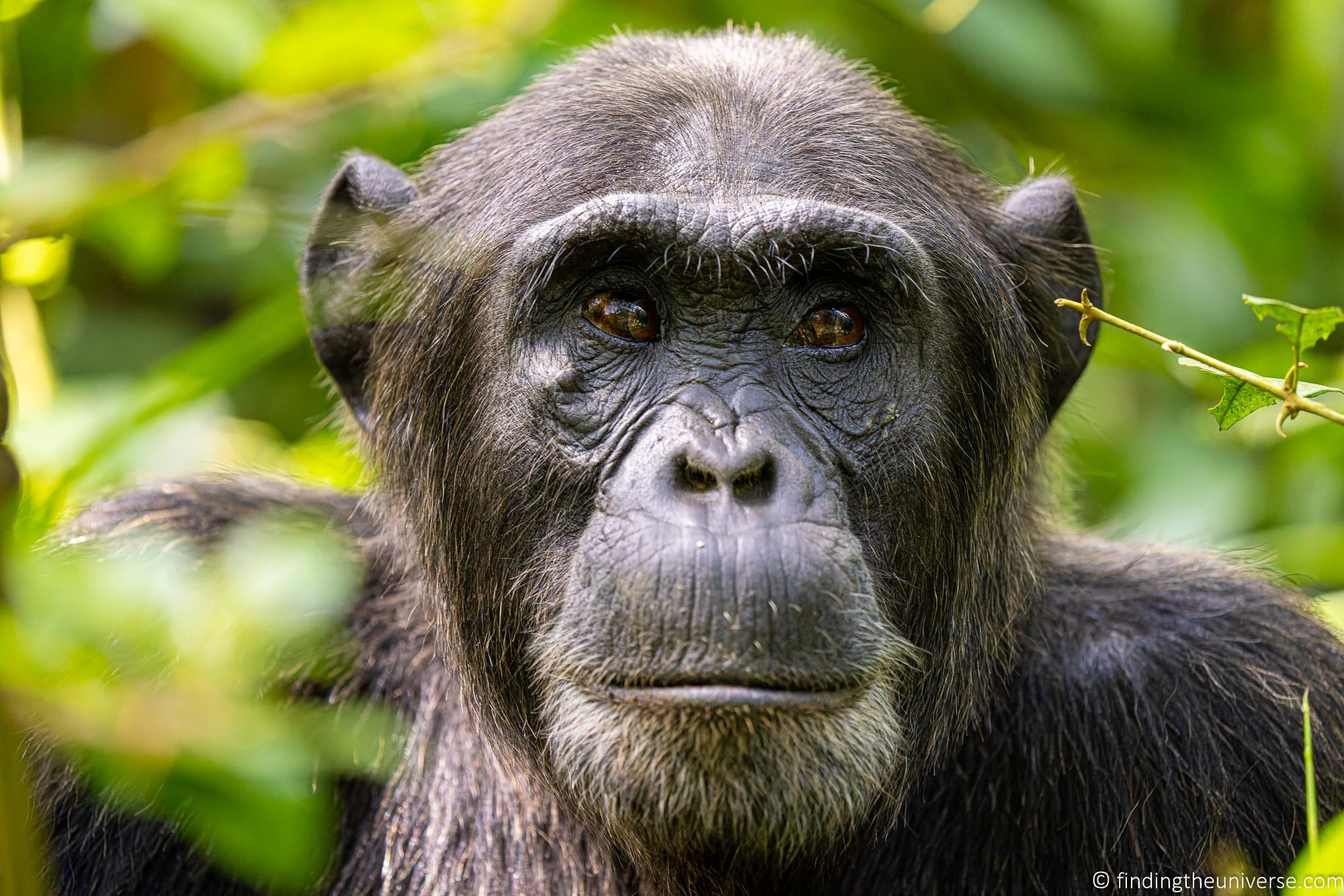
What is the Chimpanzee Habituation Experience?
As well as the standard chimpanzee trekking experience, in some locations such as Kibale National Park and Budongo Forest, you can book a habituation experience.
This is a more expensive experience, costing around $250 per person.
The habituation experience allows you the chance to visit a group of chimpanzees which is not fully accustomed to humans. It is a much longer experience, where you normally get to spend at least 3-4 hours with the chimpanzee family.
It is important to note that a non-habituated family is less used to humans. As such, you might not be able to get as close to the chimpanzees compared to a normal trekking experience. The chimpanzees are likely to move around, and they might not always be in sight. You will also likely have to trek further than in a regular experience.
If you are looking for a more natural experience where you can observe chimpanzees who are not so used to humans, as well as learn more about their behaviour, then the habituation experience is a good option. If you want to do this, we recommend booking as far in advance as possible, as there are fewer permits available for this activity compared to normal trekking.
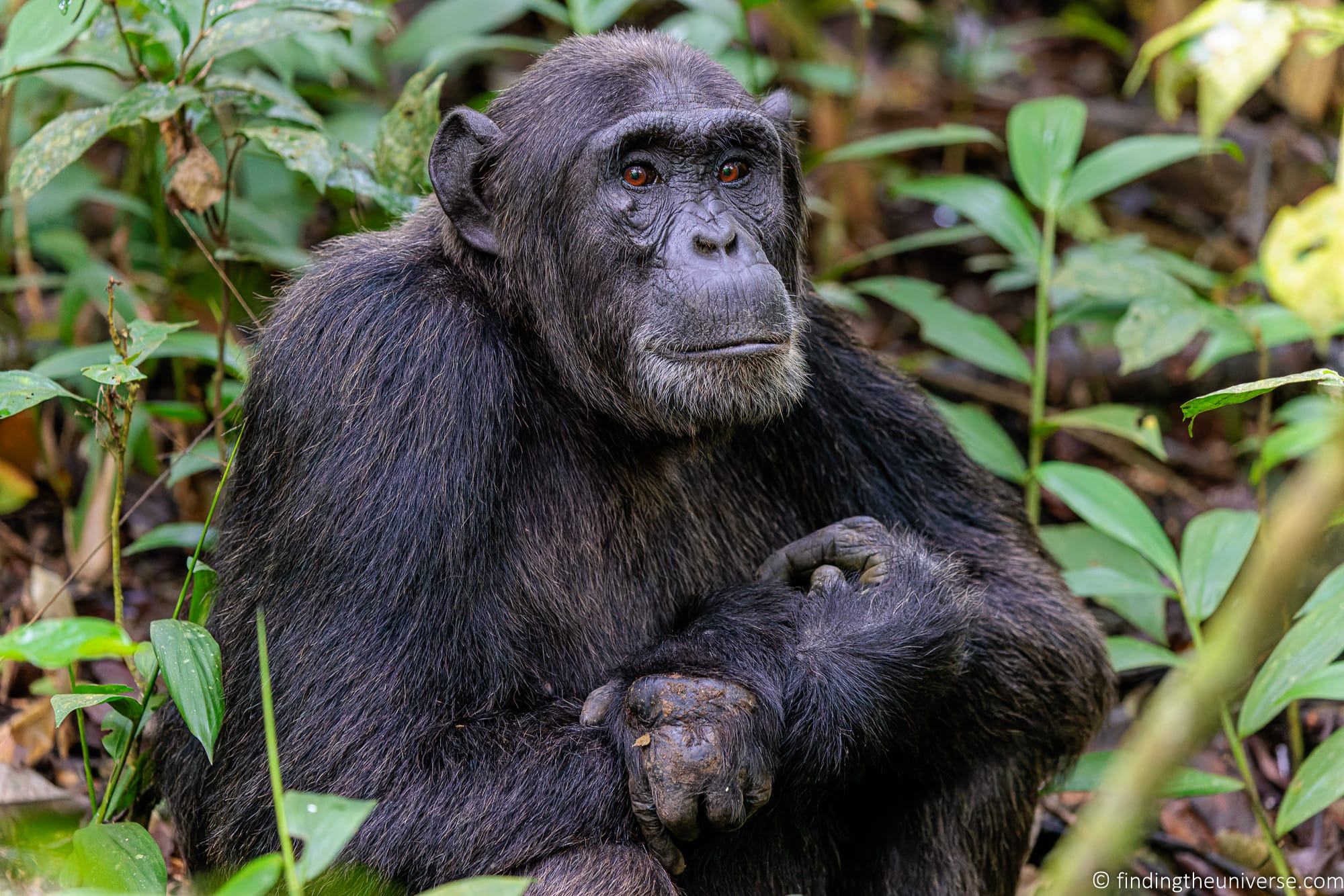
How to Book a Chimpanzee Trek in Uganda
Most visitors to Uganda book a chimpanzee trekking experience as part of an overall tour package which includes other sights and activities. This is usually the easiest option. Many tour operators book Kibale as this has the highest number of chimpanzees and the most permits available per day.
However if you want to save some money and your itinerary has flexibility, do check with your tour operator if one of the alternatives is available.
If you are planning your own self-guided tour in Uganda, then you will want to book chimpanzee trekking yourself. How you do this will depend on where you plan to go trekking.
- For Kibale, you will need to book with the Ugandan Wildlife Authority here.
- For Kyamburu, you will need to book with the Ugandan Wildlife Authority here.
- For Kalinzu, there isn’t an online booking service as far as I am aware. You can book in-person, however we recommend calling for details. Information on the website here. You can see the location on Google Maps here.
- For Bundogo, you need to book with the Bundogo Eco Lodge here.
- For Ngamba Island, you can book directly with Ngamba Island. Details here. Note this is not a trek.
Chimpanzee trekking is a popular activity in Uganda, and we highly recommend booking well in advance so as to ensure a spot.
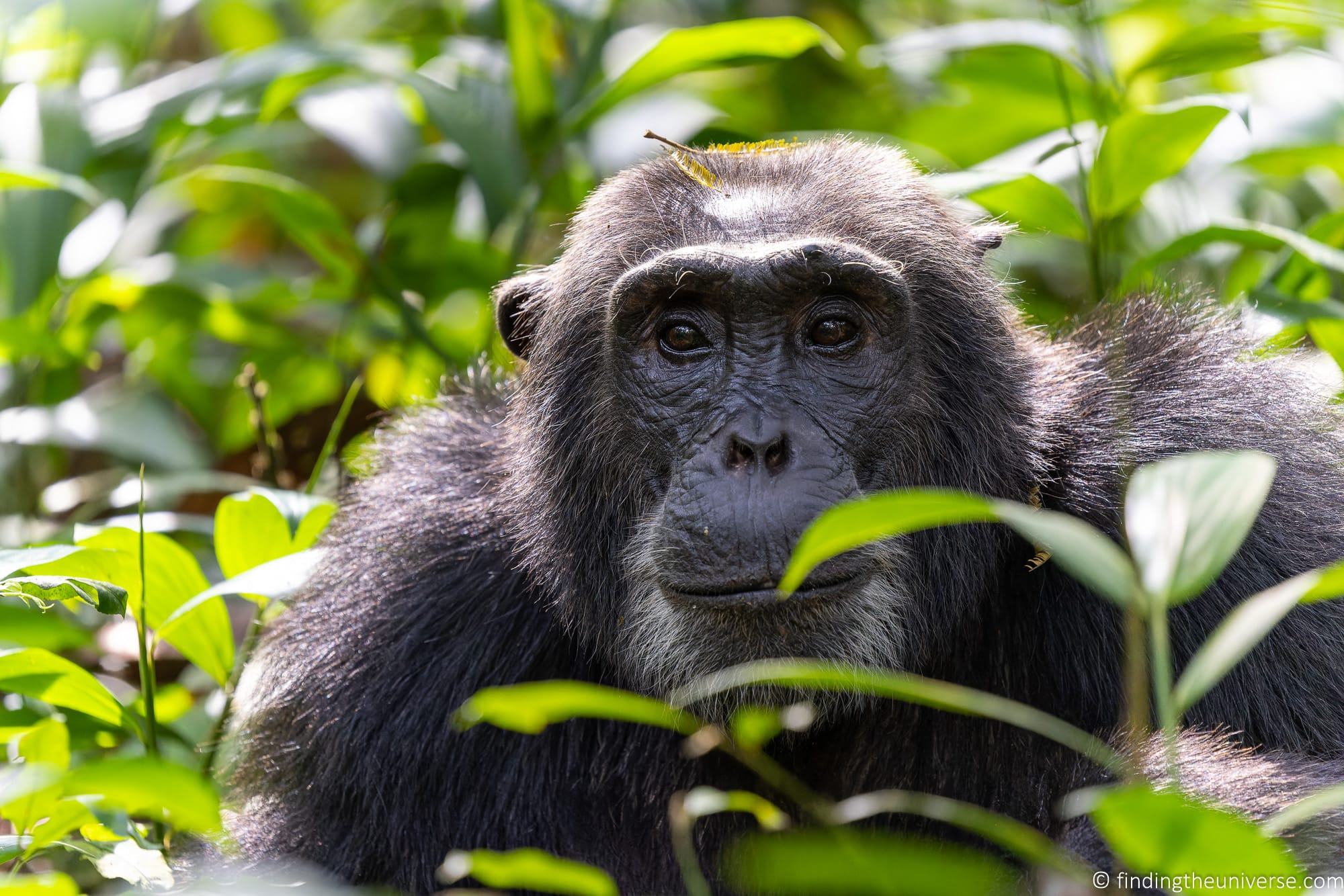
How Difficult is Chimpanzee Trekking?
Chimpanzee trekking is a physical activity which has you hiking through forested areas in order to find the chimpanzee group. It can also be quite hot and humid, depending on the time of year.
Chimpanzees are wild animals which move around of their own volition. Because of this, the distance required to hike to find them varies. You might only have to hike for a few minutes to get to a group, or you might have to hike for a few hours. Most of the time the whole experience takes 2 – 4 hours, but this can vary greatly.
The good news is that the terrain in most locations where you can go chimpanzee trekking is not too steep, and there are normally established trails to follow. So most people with a reasonable degree of fitness should not have any difficulty.
Kyamburu Gorge is one of the more challenging locations for chimpanzee trekking as the gorge has some steeper sections.
Chimpanzee trekking is generally less challenging than gorilla trekking in Uganda. However, you will still want to be prepared for a reasonable level of activity, wear appropriate clothing and footwear, and pack plenty of water.
If you would prefer to see chimpanzees without any trekking, the best option is to visit Ngamba Island. This can be reached by speedboat or motorized canoe, and you can visit, feed, and see the rescued orphan chimpanzees here. You can see more about this experience here.
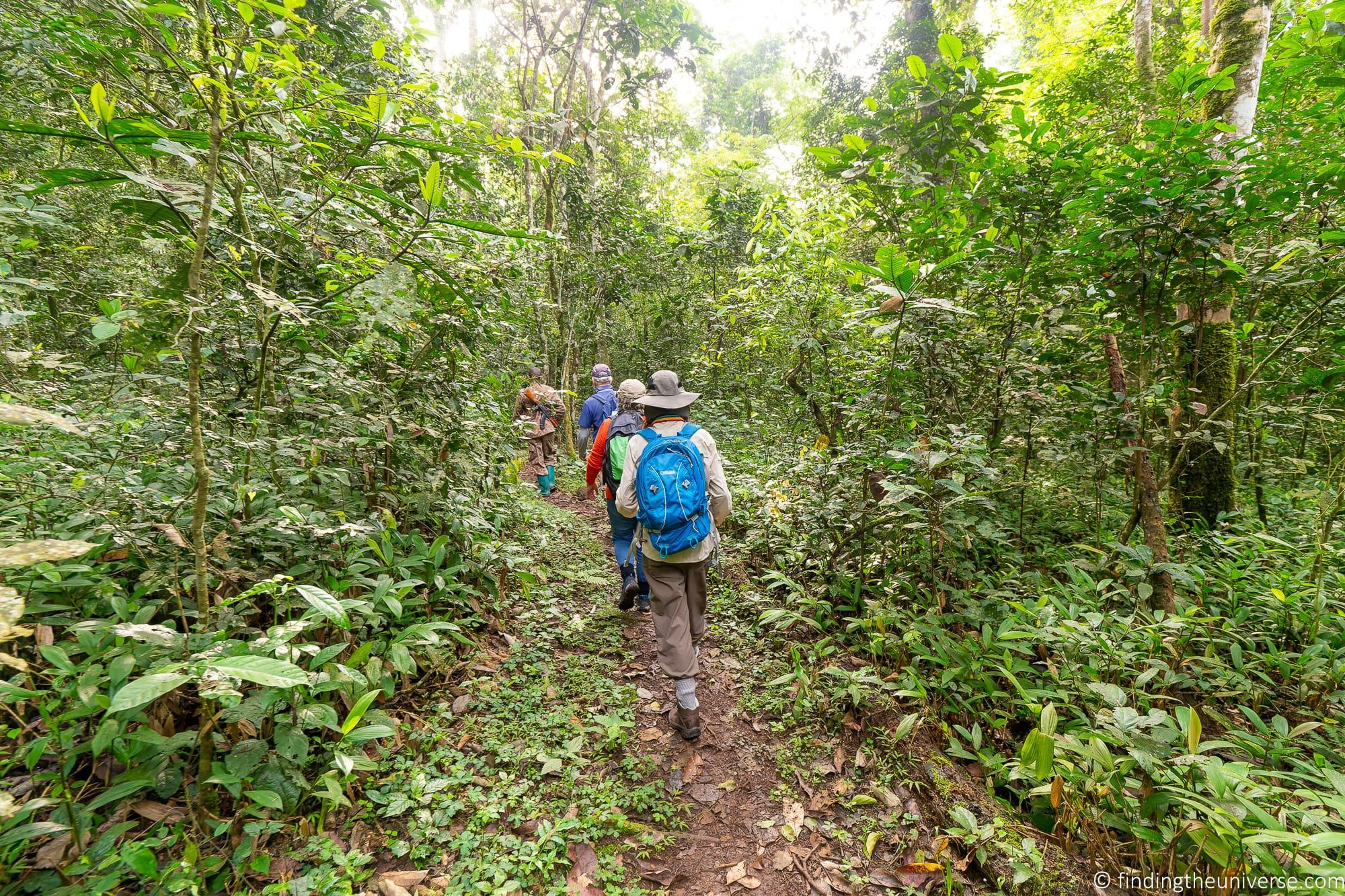
When is the Best Time to Go Chimpanzee Trekking in Uganda?
Chimpanzee trekking can be done year-round in Uganda. Generally, the best time for chimpanzee trekking in Uganda is during the dry seasons. Uganda has two dry seasons, one from December to February, and one from June to September.
Trekking in the dry season means that the trails will be dry and you are far less likely to get drenched due to a tropical downpour.
That said, there are some advantages to visiting in the wet season. First, there is a higher abundance of fruit, so the chimpanzee groups do not move as much. This means they are easier to locate and so you might not have to trek so far. In addition, pricing for accommodation and tours can be lower at this time of year.
In terms of time of day, depending on the chimpanzee tracking location you choose you may have an option between a morning, midday or afternoon trek. We would recommend choosing a morning trek where possible as the chimps are more likely to be active and foraging for food.
As the day progresses the chimpanzees tend to settle down, relax, and take a nap.
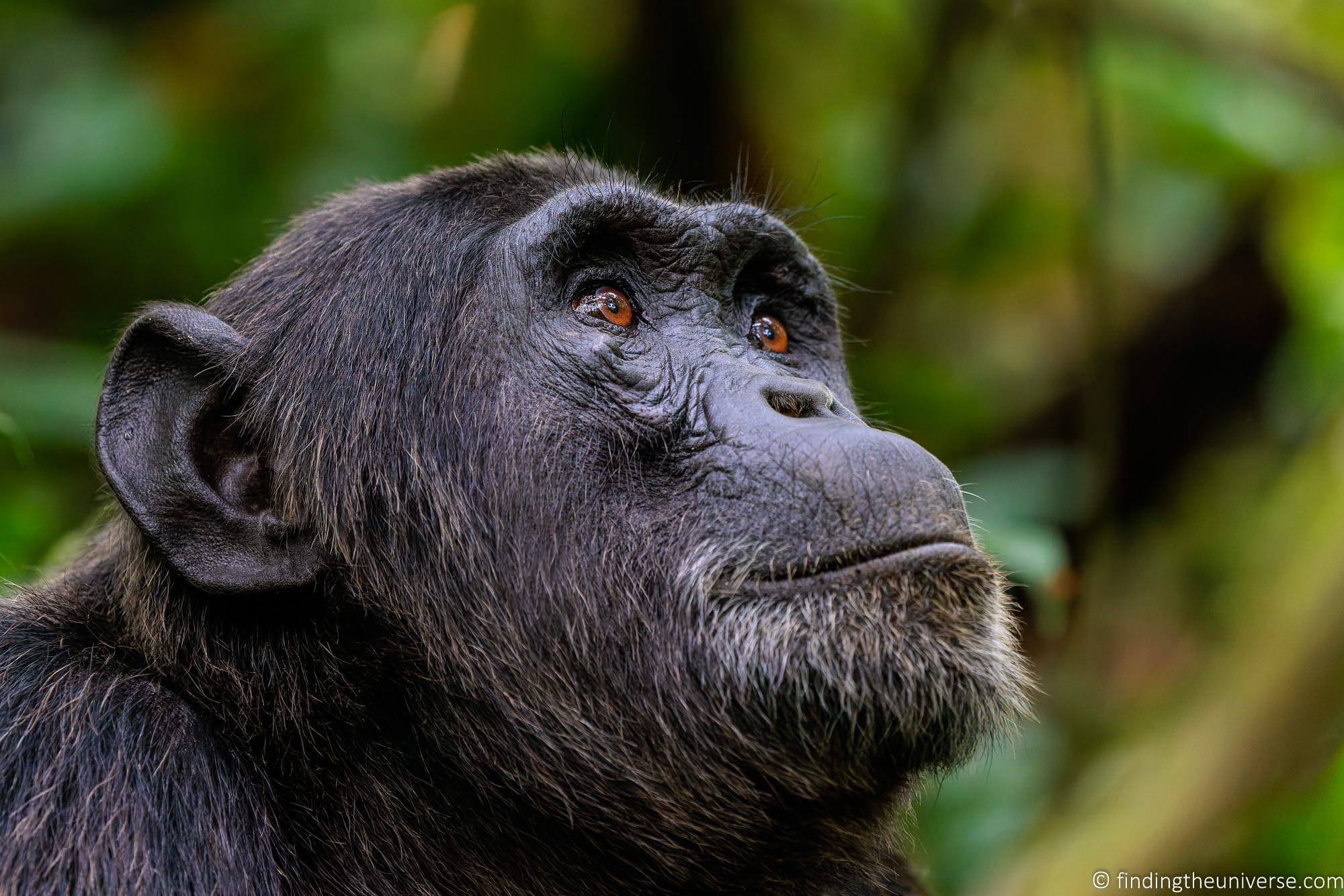
Is there a Minimum Age for Chimpanzee Trekking in Uganda?
There are minimum ages for chimpanzee trekking in Uganda. However, these vary depending on where you look.
The Uganda Wildlife website lists the minimum age for chimpanzee trekking in Uganda as 16. In previous years this age was set at 12, but as of 2022 it is listed as 16.
The Budongo Eco lodge, who handle trekking in Budongo, informed us that as of 2022 the minimum age is 15, but children aged 12 to 14 years can do chimp trekking upon the parents’ consent by completing and signing a consent form.
As a minimum therefore, children need to be 12 or over. However, you should check with your tour operator and the permit issuer when booking if you are travelling with children under 16 years of age to ensure they will be permitted to do the trek, and if there are any forms you need to complete.
If you are travelling with younger children and still want to see chimpanzees, then Ngamba Island is likely the best option as (as of 2022) they do not have any age restrictions for visitors.
Age verification is done using the visitor’s passport when purchasing or picking up the trekking permit.
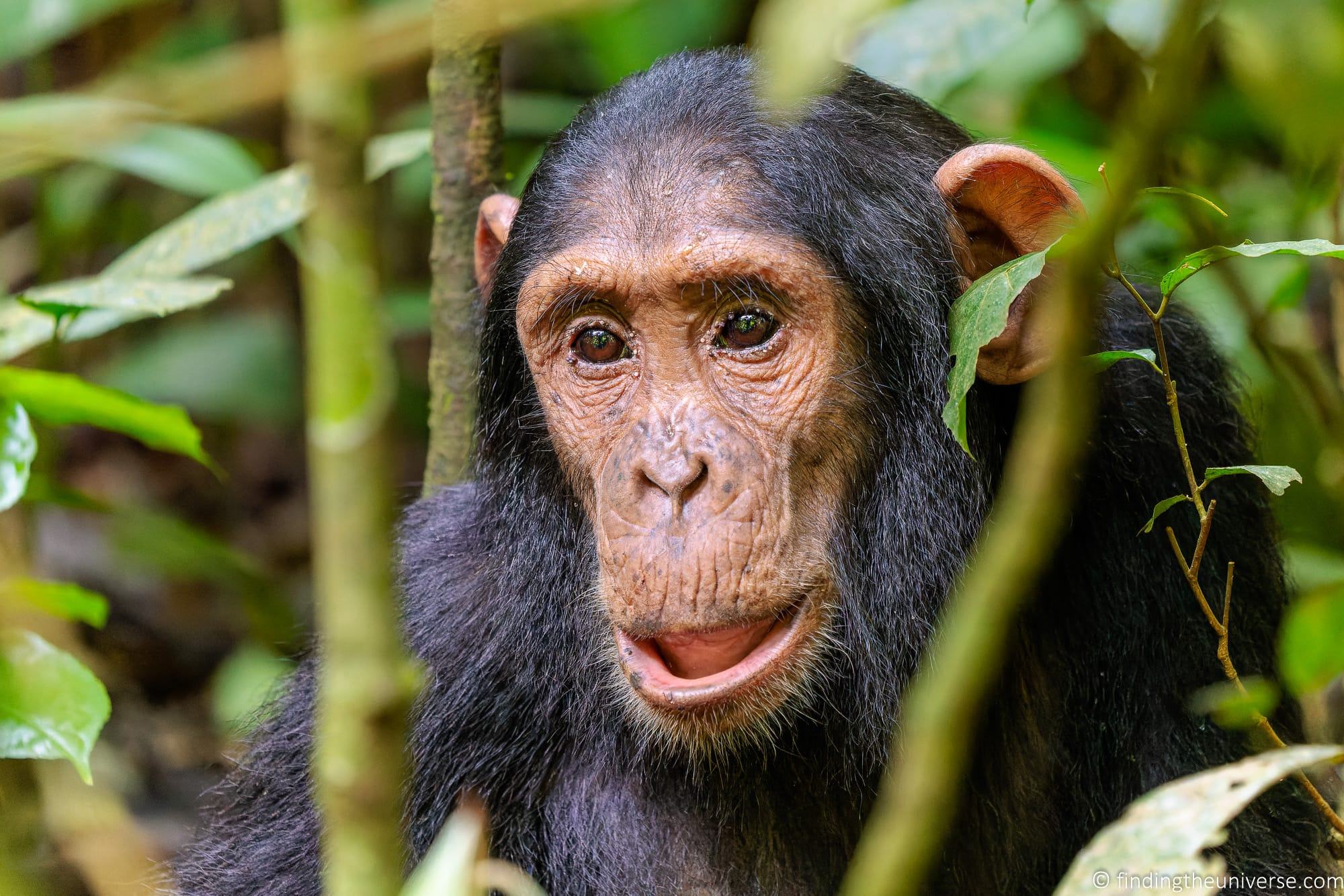
General Rules for Chimpanzee Trekking in Uganda
You will be given a full briefing before starting your trek. This will cover all the main rules. However, to give you an idea of what to expect, here are the main rules:
- Always follow the directions of your trekking guide
- As chimpanzees can catch human diseases, you are not allowed to take part in the activity if you are sick. In addition, you may have to wear a face mask when visiting the chimpanzees.
- Littering is forbidden. All litter must be carried out.
- If you need to urinate or defecate, do so off the trail. Bury your waste in a hole (30 cm deep) along with any toilet paper.
- Speak in a low voice and avoid making sudden movements or loud sounds
- Keep at least 8 meters (25 feet) from the chimpanzees at all times.
- Do not attempt to mimic the chimpanzees’ vocalisation or behaviour, this might cause a negative reaction
- Do not use flash photography.
- Do not eat, drink, or smoke near the chimpanzees
- Do not attempt to interact with or touch the chimpanzees
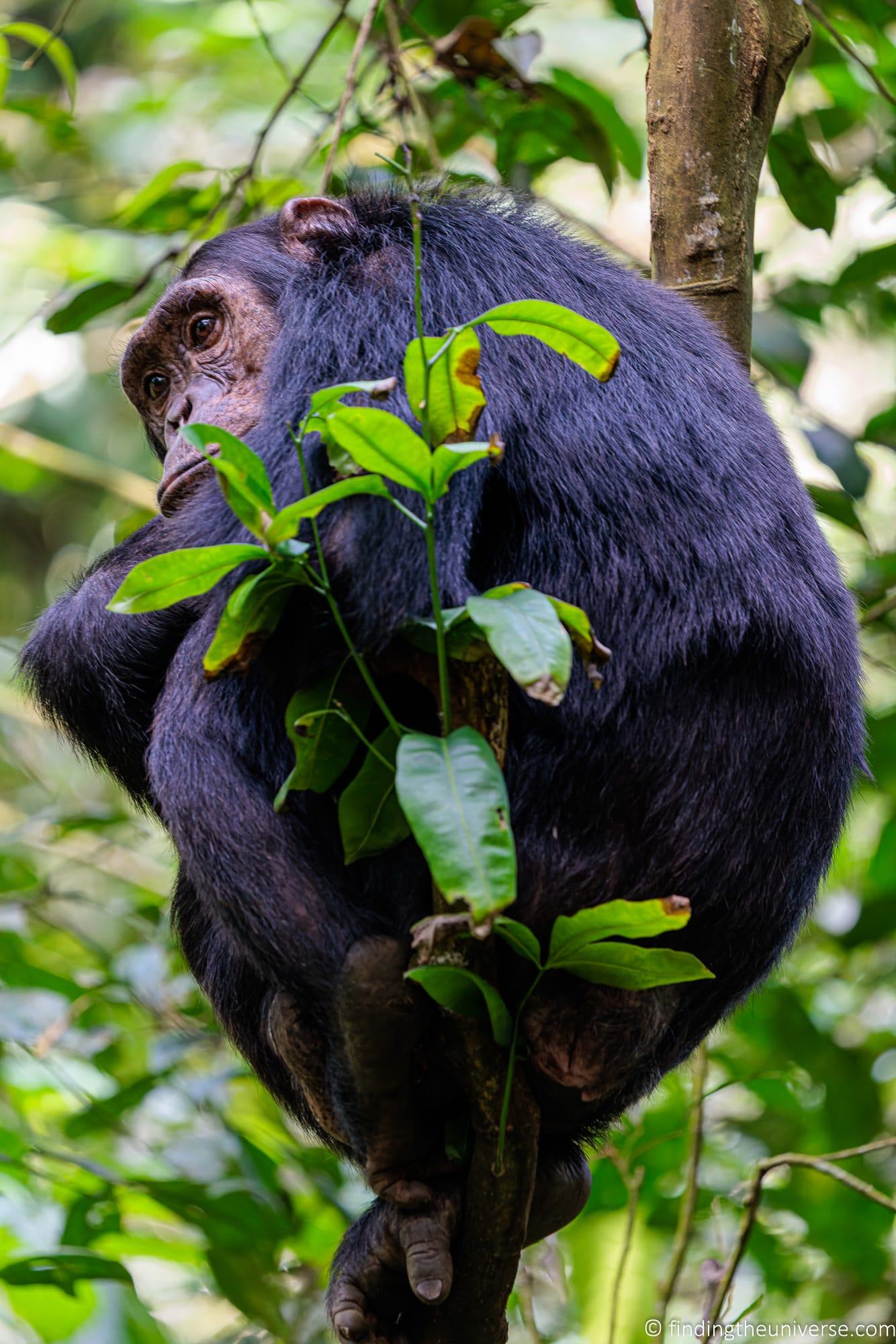
What to Pack for Chimpanzee Trekking
Now that you know what you expect, here is a quick overview of a suggested packing list specifically for chimpanzee trekking.
- Hiking boots or good trail shoes. A good pair of hiking boots or trail shoes is a good idea for chimpanzee trekking. I’d recommend hiking boots for ankle support and water proofing, but unlike gorilla trekking the trails are normally pretty good so you can use trail shoes. Just make sure you have fully broken your footwear before your trek and that they have good grip as the trails and walkways can be slippery. See our guides to the best travel shoes for men and the best travel shoes for women for some suggested brands; we both wore Scarpa hiking boots on the trek. You can search hiking boots on Amazon here and REI here.
- Hiking pants / Hiking shirt. A comfortable pair of hiking pants and a lightweight long-sleeved shirt will make for a much more pleasant trekking experience and will help protect your arms and legs from sun, branches, and insects. Look for clothing made of lightweight and breathable materials which are good at wicking moisture away. We’d also recommend bringing layers as temperatures are likely to vary across the day; we wore quick-dry T-shirts under long-sleeved button-up hiking shirts. We like the Craghoppers range of clothing, some of which also includes built in insect protection and sun protection. You can shop them from REI in the US here, as well as on their official site here. In the UK, this is their official online store.
- Waterproof Clothing or Rain Protection. Even when visiting in the dry season, there is a possibility of rain, so you’ll want to be prepared for the possibility of rain on your trek. Waterproof clothing is one option, but the downside is that given how hot it can be, you might end up being really hot and sweaty. We packed a lightweight rain jacket with hood (Laurence) and a travel poncho (Jess). Search rain jackets on REI here and on Amazon here.
- Gaiters or socks that you can tuck pants into. Before you start your trek, your guide will likely advise you to tuck your hiking pants into your socks. This is to prevent safari ants and other biting insects from going inside your trouser leg. Whilst this isn’t necessarily a common occurrence, it can be unpleasant! So we recommend wearing a pair or long socks that will let you do this, or a pair of gaiters that covers your pants and shoe area.
- Sun Protection (Hat/Sunglasses/Sunscreen). No matter when you go chimpanzee trekking, you’ll want to make sure you are fully protected from the sun. We recommend a wide-brimmed hat and sunscreen along with wearing long-sleeved shirt and trousers. Many people may also want to bring along their sunglasses.
- Daypack with rain cover. You are definitely going to need a day pack to carry your various items, including your camera, water bottles, extra clothing, and snacks. A day pack with a rain cover is a good idea in case of rain. We’d recommend one with a rain cover that attaches to the backpack in some way so it’s not ripped off by branches in the jungle. Search day packs on REI here and on Amazon here.
- Camera. You will of course want to bring along your camera. I’d also recommend bringing along a lens cloth as well as extra batteries and memory cards. See our guide to the best safari camera for some tips on what might be suitable if you are planning on investing in a new camera.
- Binoculars. It is quite common for the chimpanzees to be quite high up in the canopy, making them hard to see without assistance. A good pair of binoculars will give you a much better view, and is highly recommended for your safari in general.
- Dry bag. The chances are you will be bringing a camera with you, and you will want a way to keep it dry should you experience a tropical downpour. If it’s a smaller camera, then something like a Ziplock bag will work. Otherwise, you might consider a dry bag or backpack liner that you can put inside your daypack which will keep all your belongings dry. Search dry bags on REI here and on Amazon here.
- Snacks / Lunch. Whilst most treks last 2 – 4 hours, there is a chance that it will go on for longer than this. In this case, you are going to get hungry and will want to carry some food with you. We’d suggest packing some high energy items like nuts, dried fruit, jerky, or granola bars. Just be aware you will not be permitted to eat or take out food\ when near the chimpanzees.
- Rehydration Salts. Hiking in humid conditions will cause you to sweat a lot, and when you sweat you lose both water and salts. When hiking in these situations, we always recommend carrying some rehydration salts with you. These can be added to water to replace lost nutrients.
- Water bottle / water bladder. You are definitely going to need to drink plenty of water to stay hydrated so you will want to make sure you fill up your water bottles before leaving your hotel that morning. As a minimum you’ll want to carry at least 1 litre / 33 fl oz per person, but if it’s hot and you are doing a long hike you might want even more. If your day pack has a water bladder such as a Camelbak pack I would use that or you can just bring a regular reusable water bottle.
- Insect repellent. The jungle is obviously a place where you are going to find insects, and while trekking to see the chimpanzees in Uganda you may encounter insects such as safari ants, stinging caterpillars, and leeches. You will want to wear insect repellant to protect yourself from bites. It is recommended that you choose an insect repellent that includes at least 20% DEET as the active ingredient. Depending on where you trek you might also encounter mosquitoes which can carry malaria. We have had issues with insect repellent leaking so always keep it in a Ziploc bag.
- Passport. Don’t forget to bring along your passport as it will be checked and needed to verify your booking. Everyone in your group, including children, will need to have their passports.
- A face mask. As chimpanzees share so much DNA with humans, diseases can easily cross the species barrier. It is a common requirement, even pre-2020, for visitors to have to wear masks when visiting the chimpanzees. It’s a good idea to pack a good face mask that fits you well and you can breathe through.
- Local currency or USD for tips. Tipping is a fact of life in Uganda, and is appreciated for your guides. Local Ugandan shillings are the easiest option, but U.S. dollars are also widely accepted.
- Toilet paper. You’ll be given the chance to use the toilet before your trek and most treks last less than 4 hours. However, on a longer trek the chances of needing to go to the toilet increase, so packing some toilet paper just in case is a good idea.
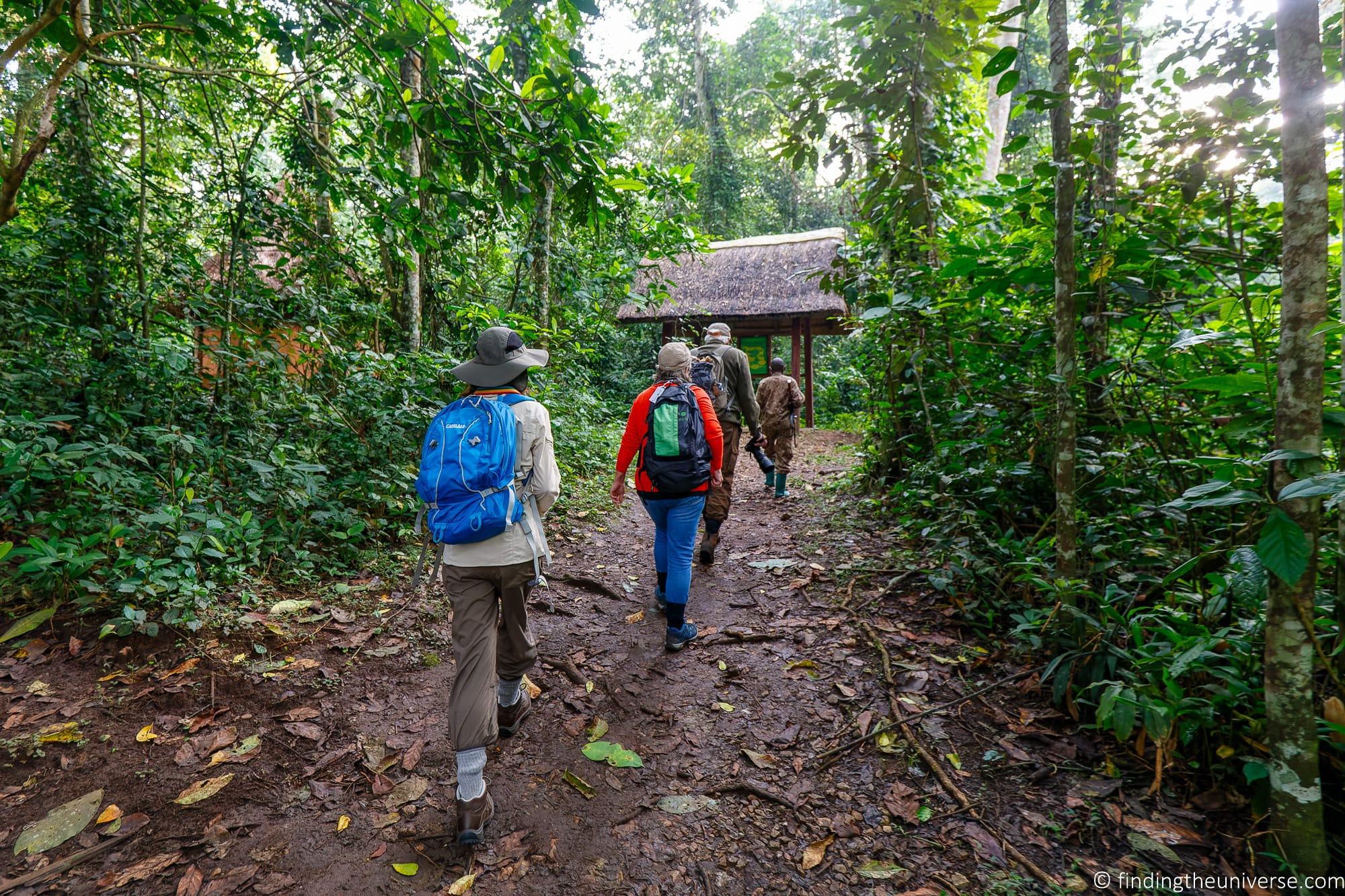
Where to Stay when Chimpanzee Trekking in Uganda
Where you choose to stay when chimpanzee trekking will of course depend on where you go trekking. We’ll outline the main locations and some of the options you have for accommodation near each chimpanzee trekking location.
If you do a morning chimpanzee trek, which we recommend, then you normally need to be at the ranger station for your briefing by around 8:00am. As such, you will generally want to stay near this location the night before, so as to minimise the driving time to the start point.
Most chimpanzee treks only last half a day, but it is possible for it to go on for longer. You might find it more relaxing to have a second night in the same hotel, so you can shower and relax after your experience.
Now we’ll look at the various accommodation options near the chimpanzee trekking locations in Uganda.
One thing to note if travelling yourself is that online maps are not always totally accurate when it comes to locations, so it is always worth checking with the hotel exactly where it is when planning your navigation.
Accommodation near Kibale Forest National Park
Kibale Forest is the most popular location for chimpanzee trekking in Uganda, and there are lots of accommodation options in the area across a range of budgets.
- Isunga Lodge – about a 20 minute drive from the chimpanzee trekking start point, this is a good value option offering private en-suite cabins and an on-site restaurant
- Kibale Forest Camp – around 15 minutes drive from the chimpanzee trekking start point, this is a good value mid-range option offering self-contained safari tents as well as non self-contained tents. Tents all feature beds and power as well as a thatched roof. There’s an on-site restaurant and bar.
- Kibale Forest Lodge – found in Bigodi village, around a 10 minute drive from the chimpanzee trekking start point and also convenient for the Bigodi wetland sanctuary walk which many visitors also do. A good value option offering private self contained rooms as well as an on-site restaurant.
- Turaco Treetops – 15 minutes drive from the chimpanzee trekking start point, this is a lovely semi-luxury lodge nestled in the forest. Private modern rooms offer balconies with jungle views, and there’s a pool and on-site restaurant. This is where we stayed when visiting Kibale.
- Crater Safari Lodge – this is a high-end lodging option around 20 minutes drive north of the chimpanzee trekking start point. Occupying a stunning location overlooking crater lake Nyinabulitwa, this luxury lodge features gorgeous private rooms with wonderful views, an on-site restaurant and bar, pool and mobile spa. If you are looking for a high-end option in the Kibale area, this would be our pick.
Accommodation near Kyamburu Gorge, Queen Elizabeth National Park
Queen Elizabeth National Park is a popular stop in Uganda, so there are quite a few accommodation options in this area. It is however worth noting that QENP is quite large, so you will want to pick a location that is close to the gorge to minimise driving distances. Here are some recommended options.
- Engiri Game Lodge and Campsite – about a 20 minute drive from the chimpanzee trekking point. This is a budget game lodge on the shore of the Kazinga channel. A range of accommodation is available, from tents to cottages. On-site restaurant and bar. A good value option in QENP.
- Enshama Game Lodge and Campsite – right next door to Engiri Game Lodge is Enshama Game Lodge, which also offers good value accommodation ranging from tent pitches to private cottages. There’s also an on-site restaurant and bar.
- Irungu Forest Safari Lodge – another good value option near the Kazinga channel, around 20 minutes drive from the chimpanzee trekking start point. It offers sites for tents as well as single, double and family cottages. On-site restaurant and bar.
- Elephant HAB Lodge – this accommodation option offers both mid-range and high-end accommodation options at a good price point. Individual rooms are all en-suite and there is an on-site restaurant and bar
- Queen Elizabeth Bush Lodge – a good mid-range option found on the Kazinga channel around 20 minutes drive from the chimpanzee trekking start point. Accommodation includes budget friendly tents as well as self-contained tents and cottages. On-site restaurant and bar.
- Enganzi Game Lodge – this mid-range hotel is around a 15 minute drive from the chimpanzee trekking point. Individual cottages offer lovely views across the national park, and there’s an on-site pool, restaurant and bar.
- Kyangabi Crater Resort – this 4* property is around a 15 minute drive from the chimpanzee trekking point. A variety of room sizes are available and there is an on-site restaurant, bar, pool and gym.
- Park View Safari Lodge – found around 25 minutes drive north of the chimpanzee trekking start point, this is a luxury option featuring high end cottages nestles amongst the trees. There’s an on-site restaurant, bar library, sauna, steam room and spa as well as a swimming pool.
- Kyamburu Gorge Lodge – Found on the edge of Kyamburu Gorge, this luxury accommodation option is the closest lodge to the chimpanzee trekking in Kyamburu Gorge. There’s even a private footpath to the trekking start point. The lodge offers eight bandas (chalets), four standard and four luxury. Bandas have private butlers, indoor and outdoor showers, and there’s a spa and swimming pool.
Accommodation near Kalinzu Forest Reserve
Kalinzu Forest Reserve is only about a 30-45 minute drive south of Kyamburu Gorge, and as such many visitors choose to stay at the accommodation options around the gorge, where there are quite a few options. There are also some more budget focused options in Ishaka, around a 25 minute drive to the south.
The only accommodation available in Kalinzu Forest Reserve itself is a basic campsite in the Forest Station at Nkombe. This has solar powered showers and pit latrines, but visitors must bring their own camping equipment.
- Cicelo Country Inn – 20 minutes drive south of the Kalinzu chimpanzee trekking start point, this is a budget focused guesthouse offering cosy en-suite rooms with work areas. On-site restaurant available.
- Belline Hotel – 25 minutes drive south of Kalinzu chimpanzee trekking in the small town of Ishaka. Budget accommodation, private rooms with en-suite. On-site restaurant and bar.
- Engiri Game Lodge and Campsite – about 45 minutes’ drive north of the Kalinzu chimpanzee trekking location, and also listed under Kyamburu Gorge lodging options. This is a budget game lodge on the shore of the Kazinga channel. A range of accommodation is available, from tents to cottages. On-site restaurant and bar. A good value option in QENP.
- Enshama Game Lodge and Campsite – about 45 minutes’ drive north of the Kalinzu chimpanzee trekking location, and also listed under Kyamburu Gorge lodging options. Found next door to Engiri Game Lodge, offers good value accommodation ranging from tent pitches to private cottages. There’s also an on-site restaurant and bar.
- Elephant HAB Lodge – 30 minutes’ drive north of the Kalinzu chimpanzee trekking location, and also listed under Kyamburu Gorge lodging options. Offers both mid-range and high-end accommodation options at a good price point. Individual rooms are all en-suite and there is an on-site restaurant and bar
- Kyamburu Gorge Lodge – 30 minutes’ drive north of the Kalinzu chimpanzee trekking location, and also listed under Kyamburu Gorge lodging options. Lodge offers eight bandas (chalets), four standard and four luxury. Bandas have private butlers, indoor and outdoor showers, and there’s a spa and swimming pool.
Accommodation near Budongo Forest
There are fewer accommodation options in the Budongo Forest area, although there are still a few choices. The most obvious being Budongo Eco Lodge itself which is where tours depart from.
- Budongo Eco Lodge – found in the heart of the Budongo Central Forest Reserve, this lodge is where the chimpanzee trekking in this area starts from, so it makes a lot of sense to stay here as well. It’s a good value 2* lodge offering both private cabins and dormitory style accommodation. There’s an on-site restaurant and the lodge can arrange other activities as well as chimpanzee trekking.
- Masindi Hotel – 40 minutes drive south of the Budongo trekking start point, this is the oldest hotel in Uganda. A range of accommodation is available, including a camping area, dormitory accommodation, en-suite rooms and a suite. There’s also an on-site restaurant.
- Sambiya River Lodge – 30 minutes’ drive to the north of the Budongo trekking start point, this midrange lodge offers good value private cottages as well as a pool and restaurant.
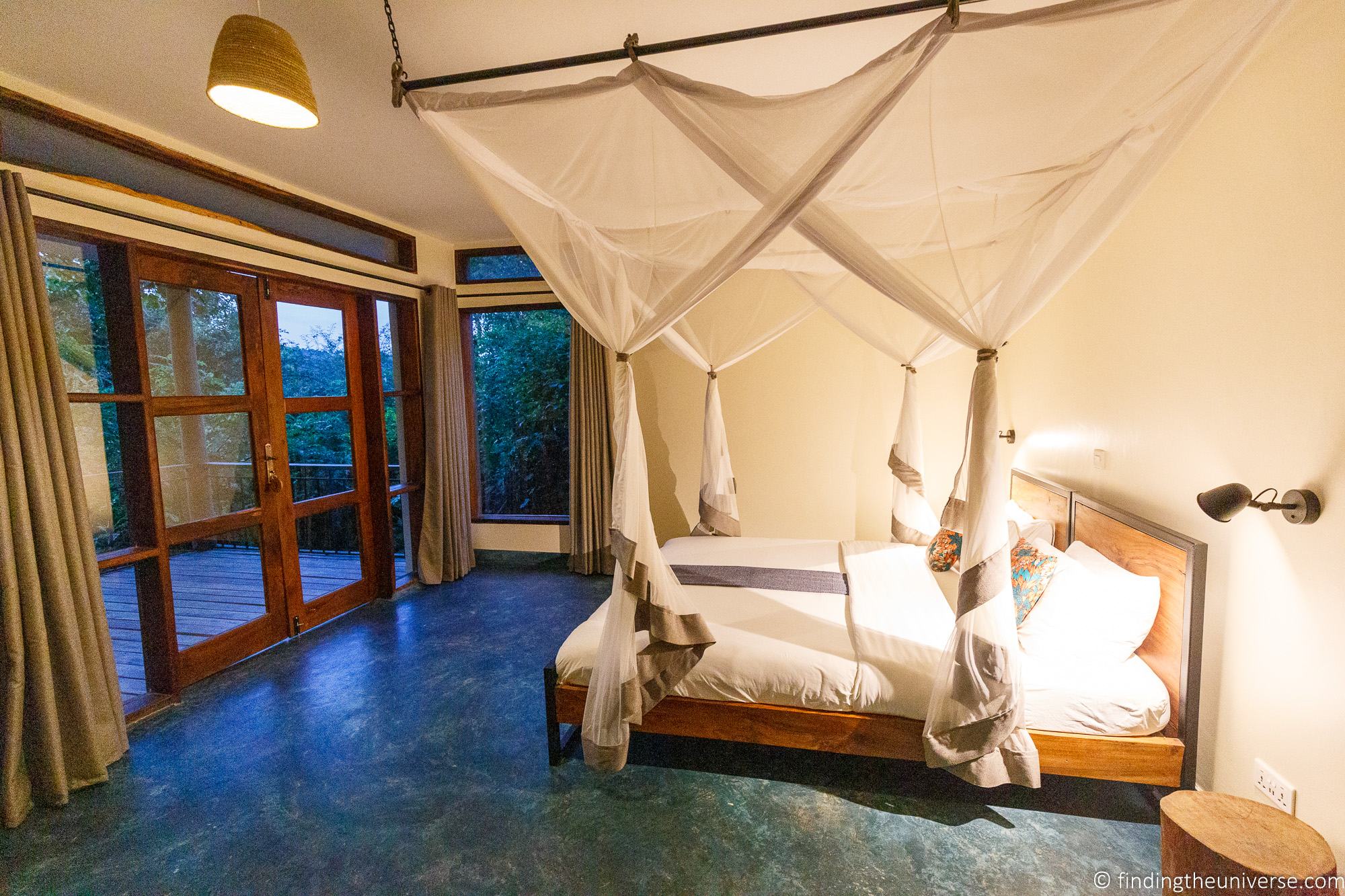
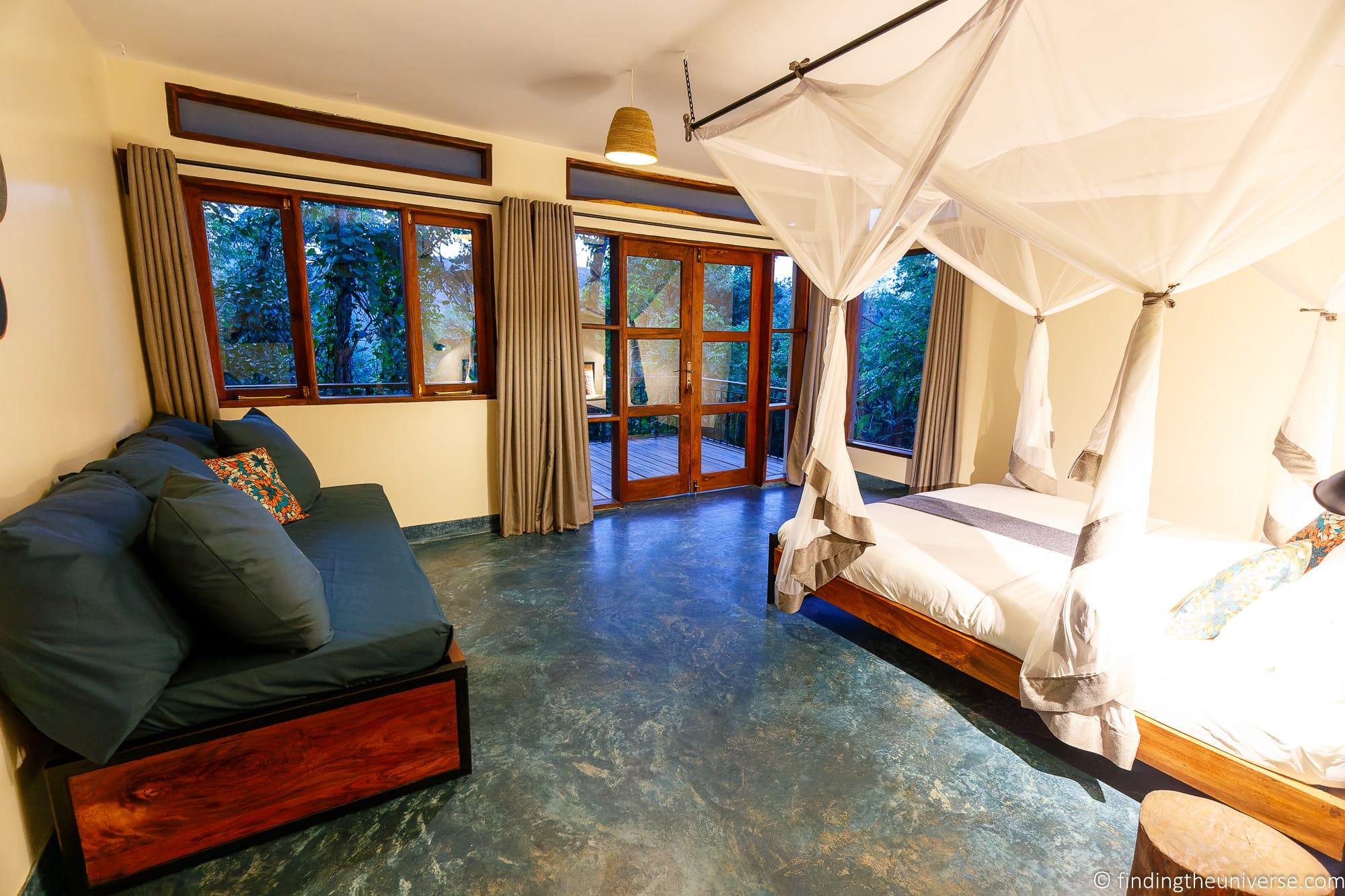
Our Experience Chimpanzee Trekking in Uganda
We went chimpanzee trekking in Uganda as part of a longer trip around Uganda, Kenya, and Tanzania. We spend 12 days in total in Uganda, and we also went gorilla trekking in Uganda.
We are fairly active, but are certainly not super fit. We wanted to share our experience to give you an idea of what it was like for us. Chimpanzees are wild animals and of course every experience will be different, but this should be a fairly representative experience we believe based on our conversations with our guides.
We did our chimpanzee trek in Kibale Forest National Park. We stayed overnight the night before at Turaco Treetops, where we also spent the night after our trek was complete. We were scheduled in for the morning chimpanzee trekking session.
Our day started early with a 7am breakfast, and we departed our hotel at 7.40am. It was around a 15 minute drive to the ranger station, so we arrived just before 8am.
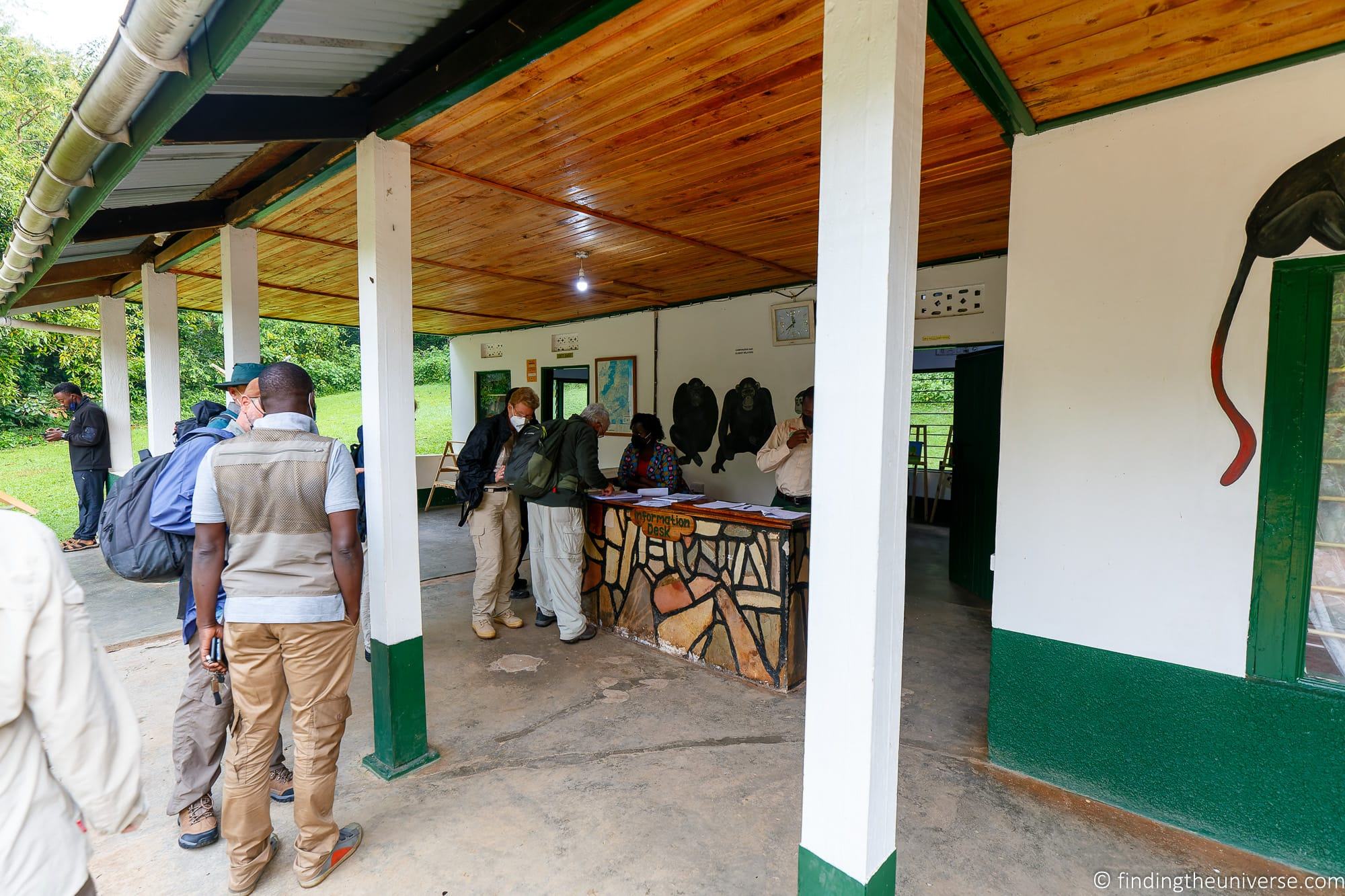
The trekking center was fairly busy with a number of other vehicles and guides. Our guide registered us (we provided our passports), and then everyone went into a briefing room. Here the lead ranger walked us through what to expect from the trek, some information on chimpanzees, and outlined the rules.
We were then split into groups of up to six. Our group was five people, myself and Jess and then a group of three. On the day we visited we estimated there were total around 30 – 40 other tourists.
Once we were divided into our groups and assigned a ranger, we were given a few minutes to collect our stuff and use the toilets if needed. Then we set off into the forest behind the ranger station in search of the chimpanzees. The groups set off a few minutes apart from each other, but took different trails, so we didn’t really feel we were on top of other groups.
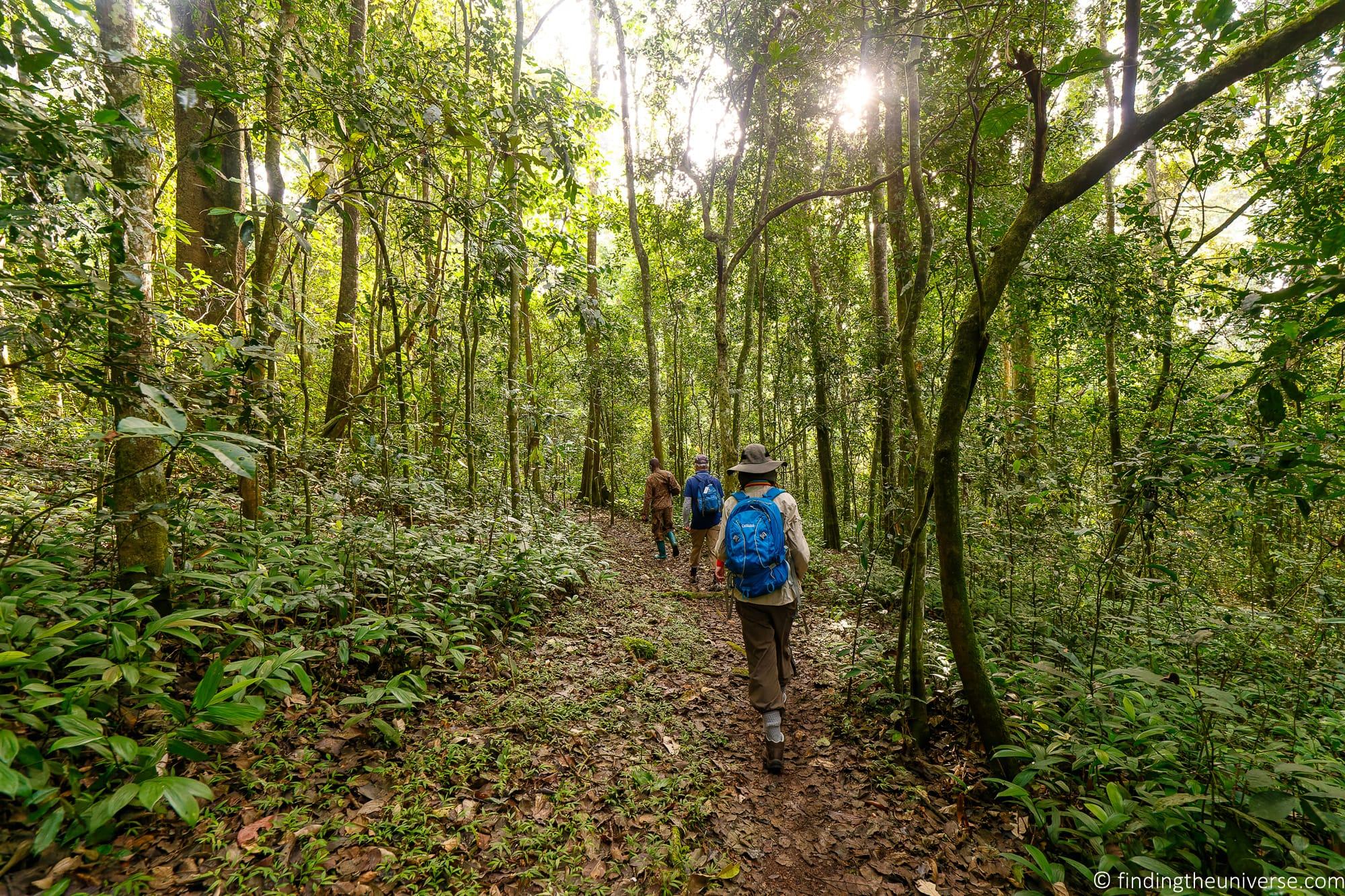
The trail was well cut and easy to follow, and whilst it was hilly, it was not too steep. Temperature wise, the day started off quite cool but temperatures rose over the day. In some parts there were wooden walkways across more muddy areas. These walkways were slippery in parts. One lady in our group did slip on these but did not injure herself thankfully.
We actually saw a couple of chimpanzees high up in the canopy in the first twenty minutes of our trek, a mother and a young chimp. They were quite high up and hard to see, but it was at least a sighting. We also saw a red-tailed monkey in the treetops, although from a distance.
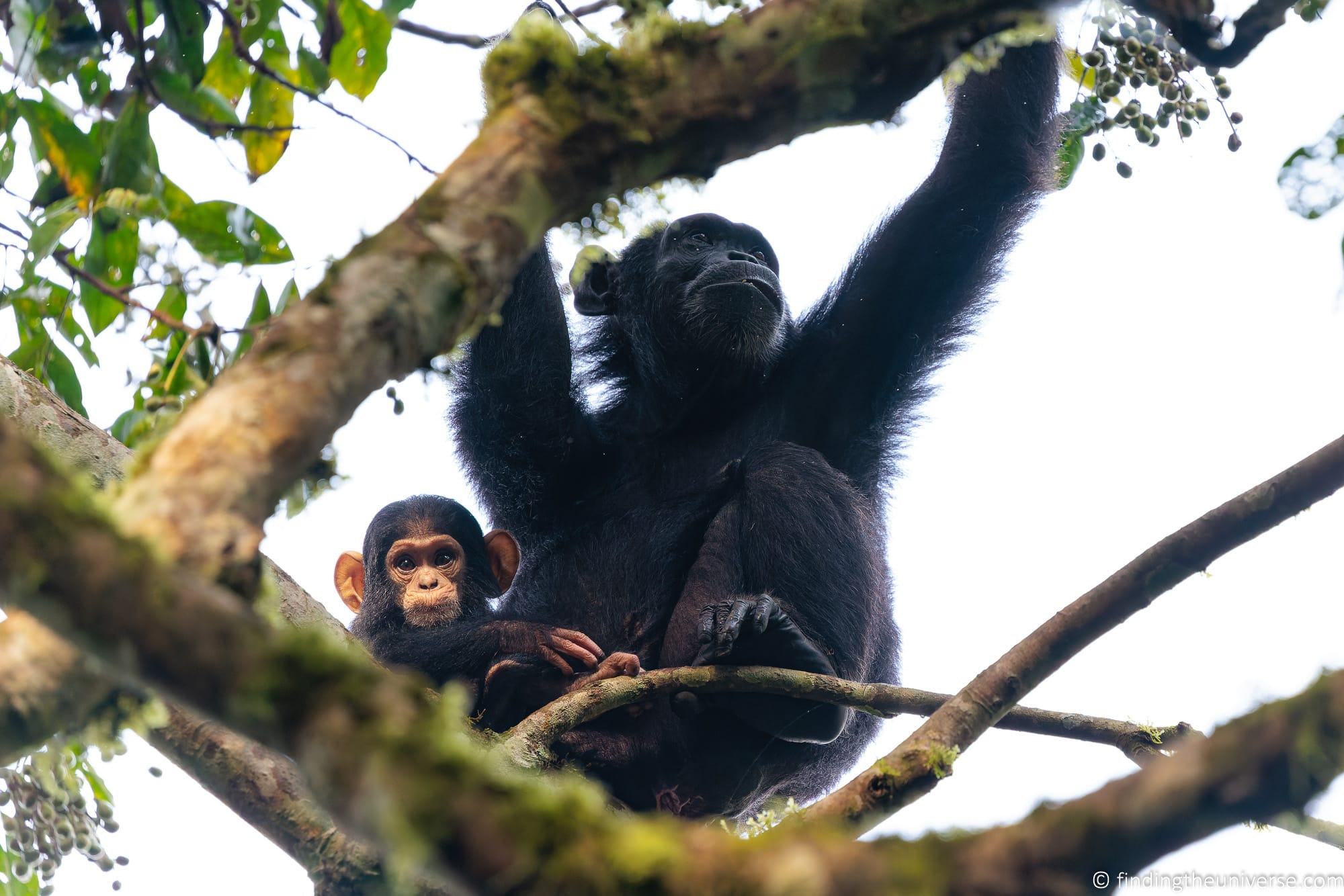
We then walked on, and had a couple more similar sightings. Finally, our ranger learnt that the main group had been sighted, and after an hour or so of total trekking we converged with the other groups.
There was a large number of chimpanzees far up in the canopy, at least fifty, but it could have been many more. They were still quite high up, but with binoculars and a telephoto zoom lens we were able to see them. They were mostly eating leaves and sitting around, and didn’t show much interest in us humans far below.
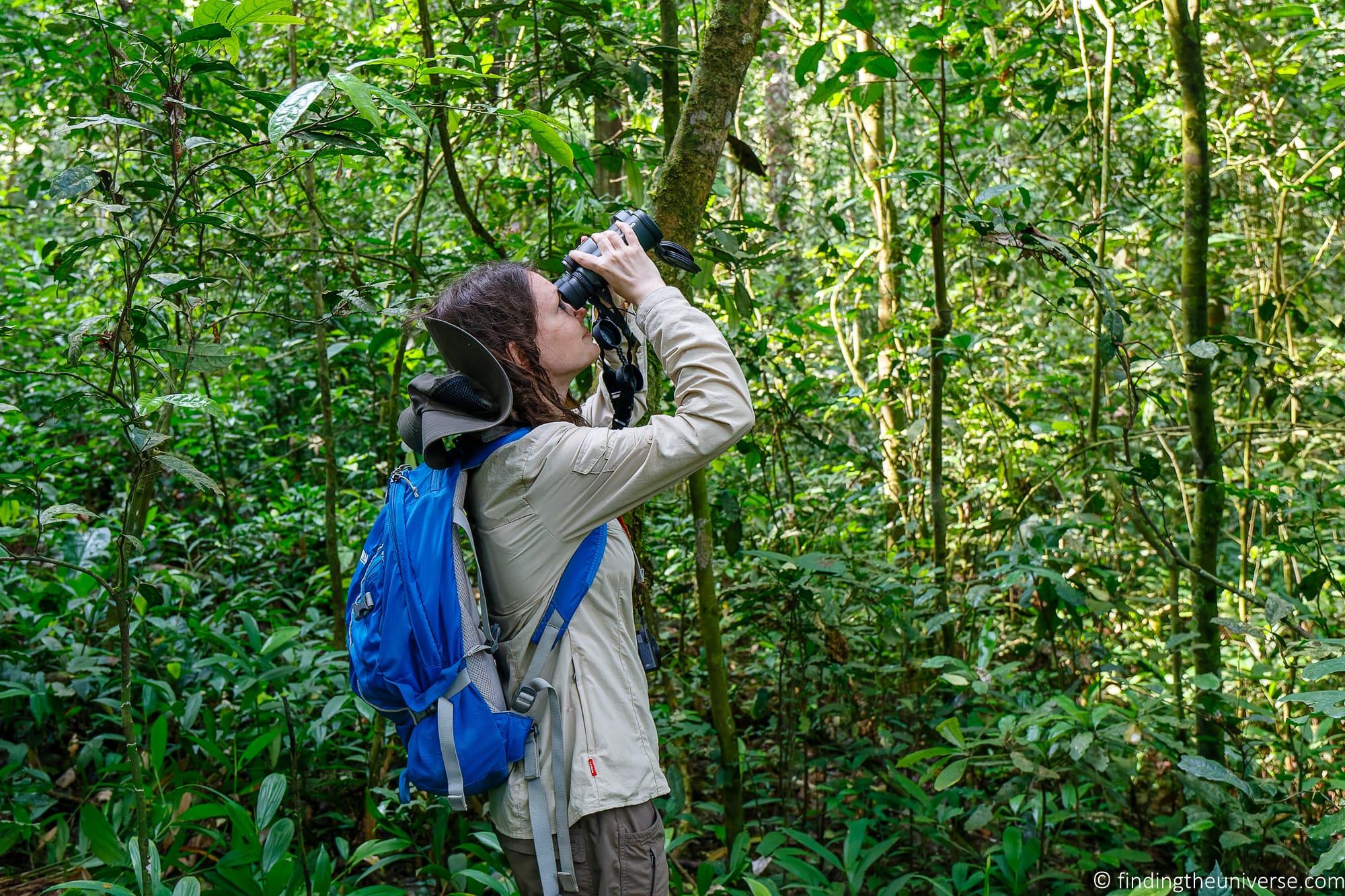
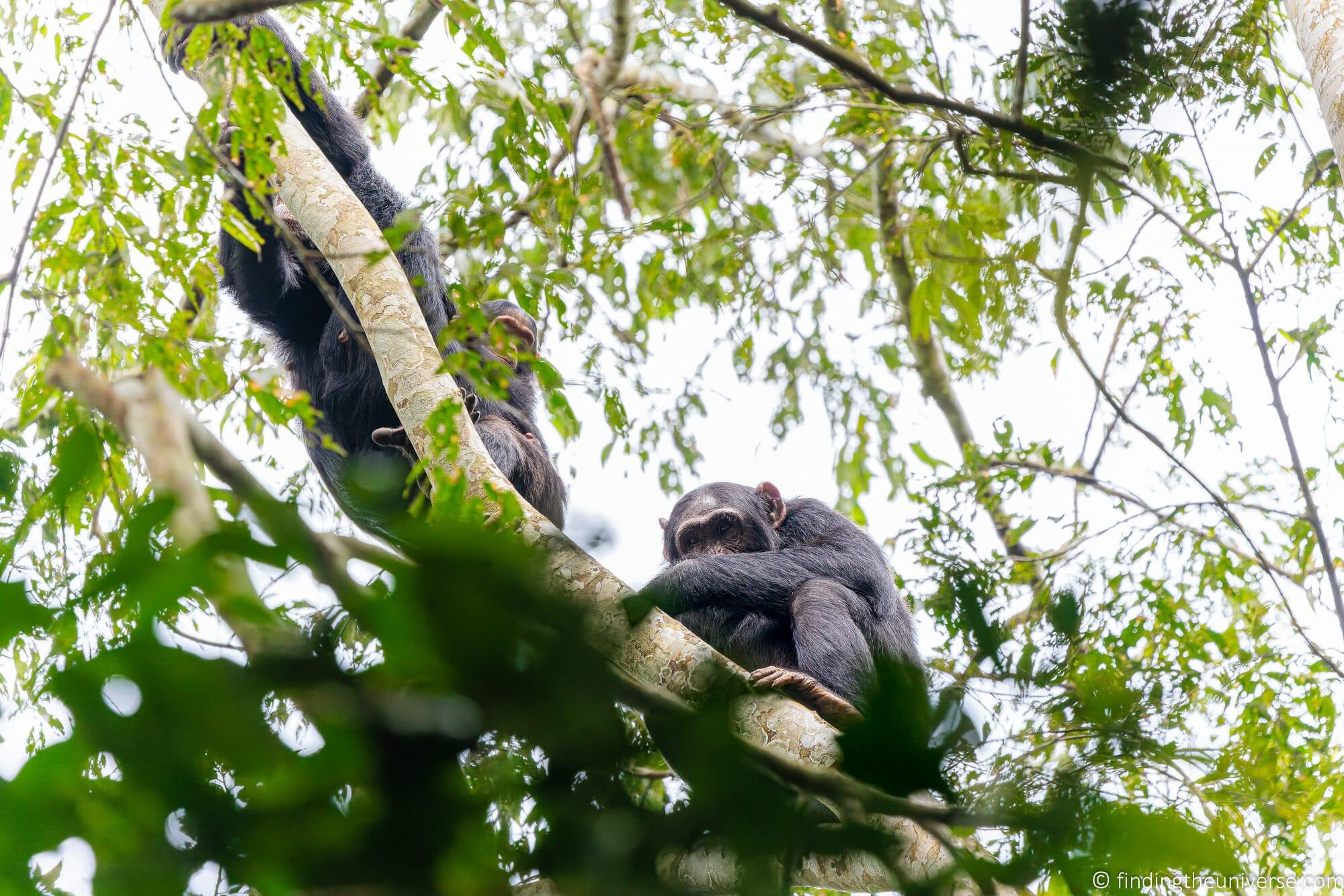
All the tourist groups had converged by this point, so whilst we were still separated into our smaller groups of six, there were now around 30-40 people in the same area.
We watched the chimpanzees high up in the trees for around an hour. Finally, one chimpanzee started to descend. She got almost to the floor before pausing for a while. Then she was on the forest floor.
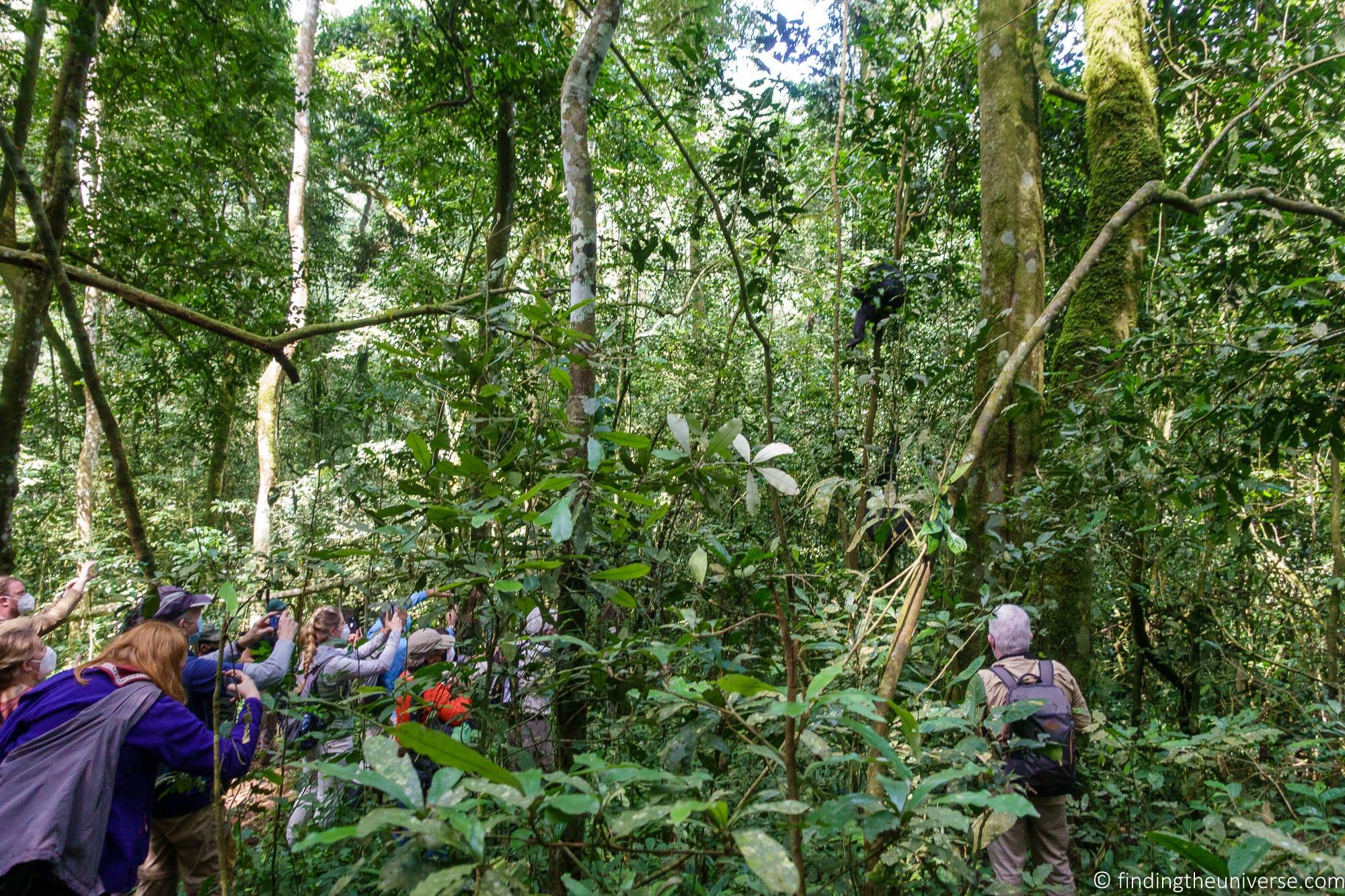
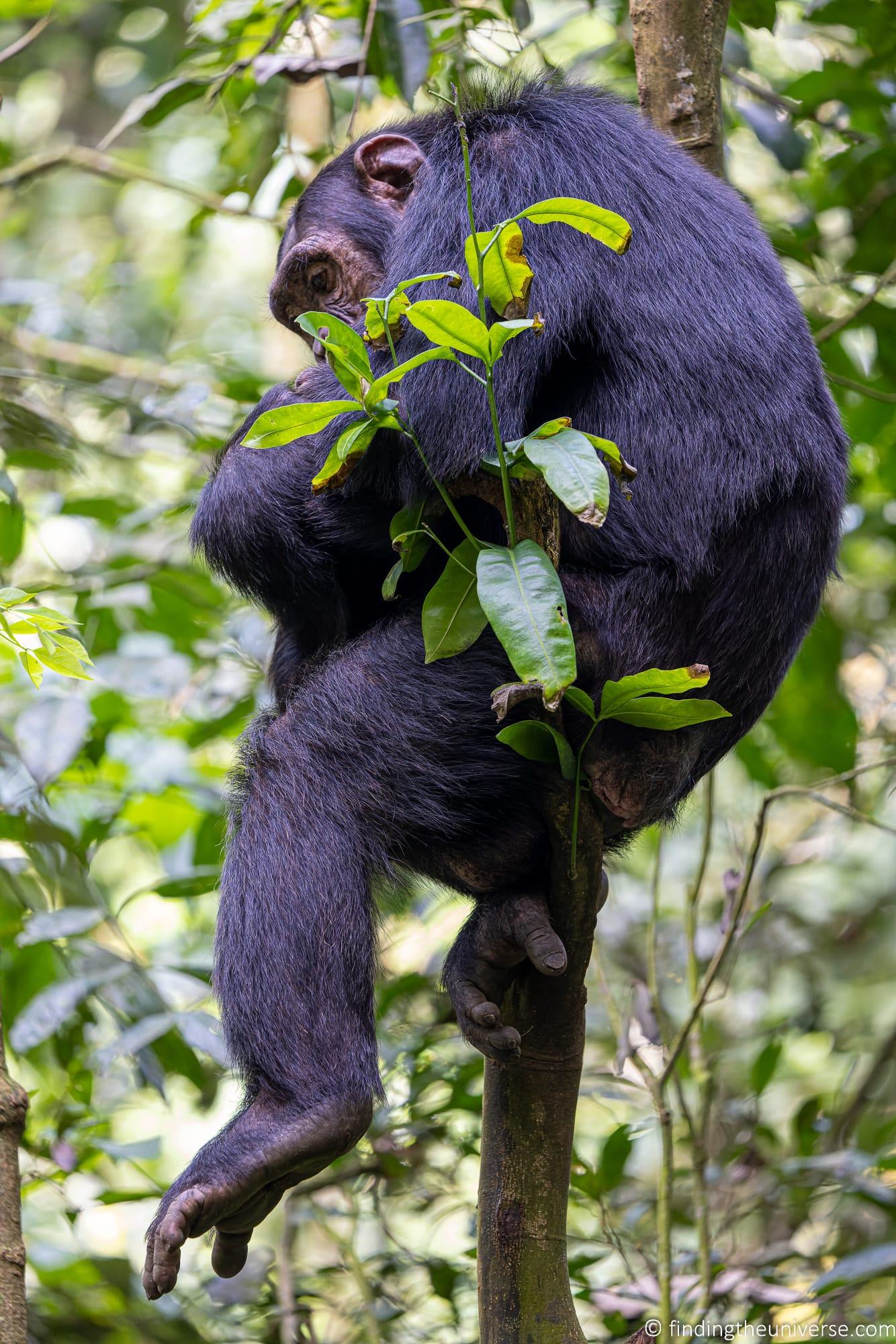
Moments later, the rest of the group started to descend. At this point, the rangers regrouped us into our individual groups, and each group started to slowly follow a chimpanzee or two. They were moving through the forest in search of food or somewhere to lie down, so we were able to observe them quite closely and get some photos.
Whilst we obviously had to observe the strict distancing rules, the chimpanzees were not aware of them. So sometimes a chimpanzee would walk by very close to us, which was quite exciting. Most of them were very relaxed and really not bothered about the sweaty hot humans clicking away on their cameras.
A few of the more wary chimps, particularly those with babies, went far away from the humans or hid in the bushes. Never to be seen again.
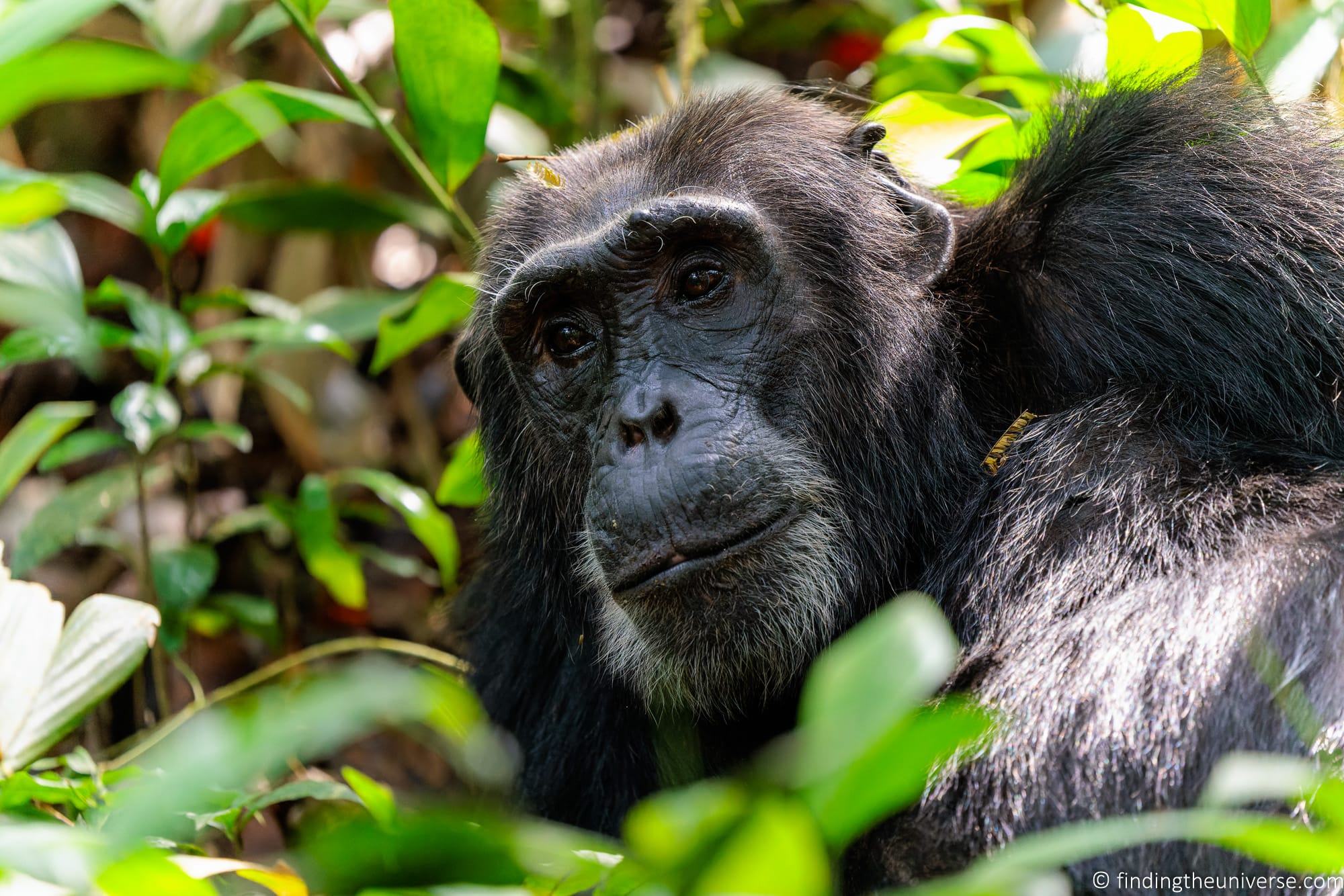
We trailed the chimpanzees for around 40 minutes on the ground, taking a lot of photos and getting the opportunity to observe them quite close up, which was a wonderful experience. Finally, our guide said our time had come to an end, and we started to head out.
We actually finished the trek in a slightly different location than we started which resulted in a less walking than going all the way back to the centre. Our guides were called to the location by the rangers to meet us there and take us back to the trekking center.
At the trekking center we were each given chimpanzee trekking certificates with our names on them. We were also given the chance to use the toilets or buy souvenirs before heading back to our hotel.
In total, our time from leaving the trekking center to getting picked up at the end was just over 3.5 hours. We spent about 1 hour trekking to find the chimps in the beginning, about 1 hour observing the chimpanzees high up in the canopy, about 40 minutes watching the chimps on the ground, and about 45 minutes walking back and waiting for the transfer back to the trekking center.
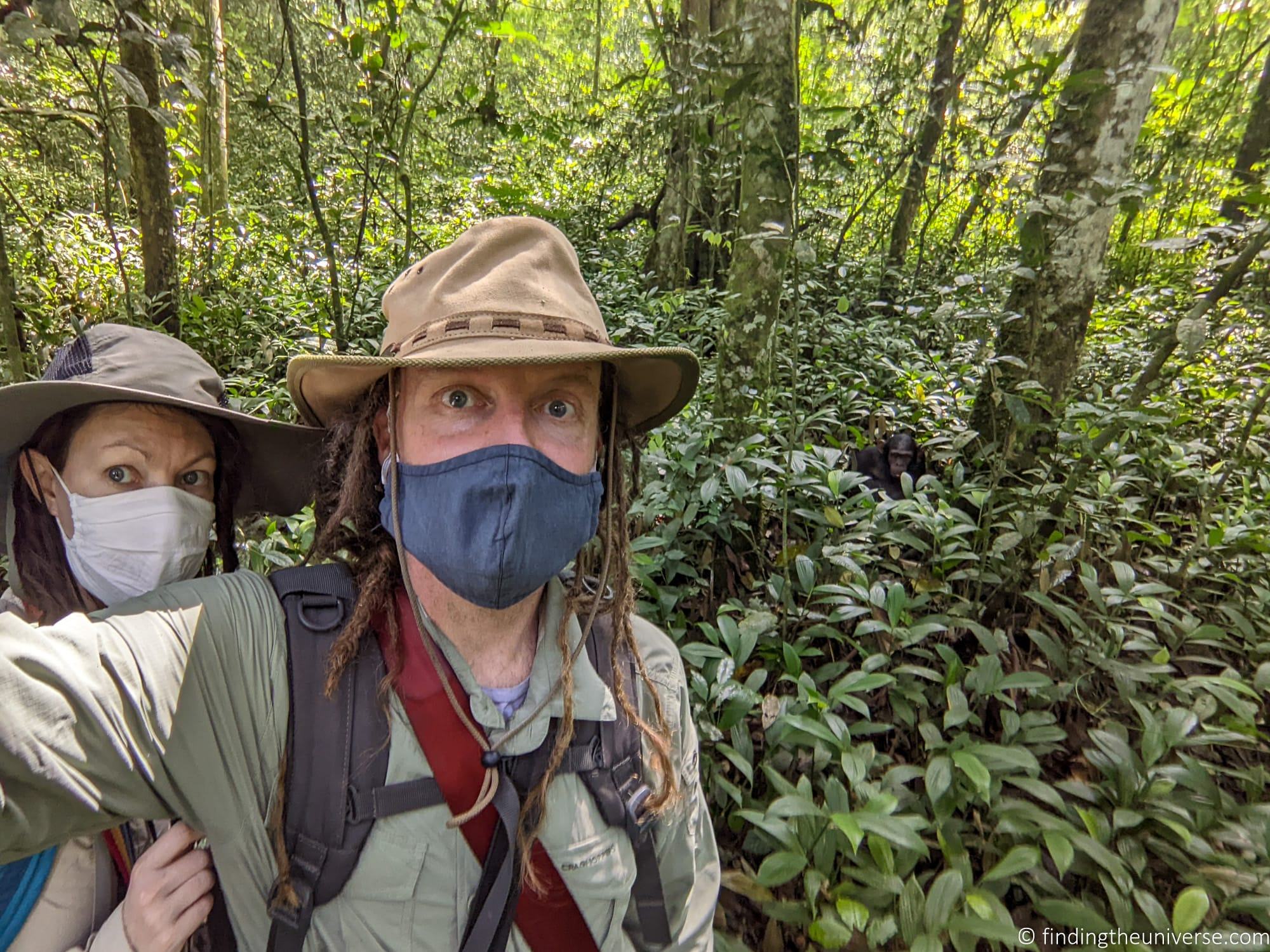
Chimpanzee Trekking vs Gorilla Trekking
When you visit Uganda, you will have the opportunity to do both gorilla trekking and chimpanzee trekking. You might be wondering what the differences are, other than the obvious difference that the animals being trekked are different! As we have done both, we wanted to share a quick overview of the key differences.
These are obviously generalisations, as every experience can differ. However, in general:
Cost: Chimpanzee trekking is a lot less expensive than gorilla trekking. In 2022, the cost for chimpanzee trekking ranged from around $50 up to $200 depending on location. Gorilla trekking permits are $700 per person for a visitor.
Difficulty: In general, chimpanzee trekking is easier than gorilla trekking. The terrain for most gorilla trekking is steep and can require navigating directly through the jungle without a trail so it is recommended only for those with a good level of physical fitness. Chimpanzee trekking is normally on easier terrain and in most situations the trails are already cut.
Honestly, we enjoyed both experiences and can recommend doing them both. However, if budget and difficulty are a concern, chimpanzee trekking is a very worthwhile experience.
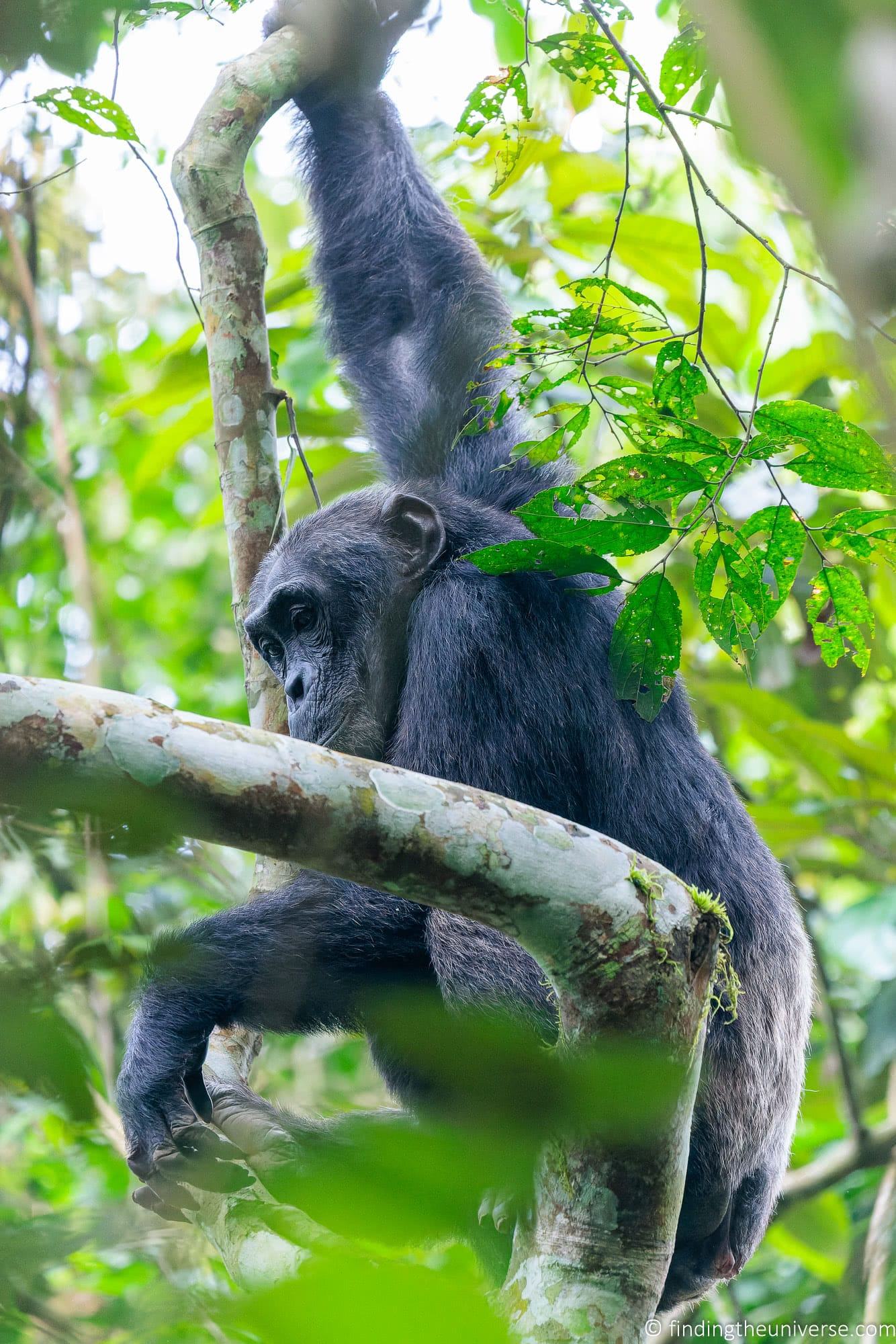
Tips for Visiting the Chimpanzees
We wanted to share some tips with you to help you have the best possible chimpanzee trekking experience.
- Improve your fitness before your trip. Whilst chimpanzee trekking is generally not as physically challenging as gorilla trekking, it can involve a hike of a few hours in hot conditions. As such, being physically fit prior to setting off will make the whole experience more pleasant.
- Pack and dress appropriately for the hike. Dressing appropriately for the hike and packing everything you’ll need in your day pack will ensure you are prepared and comfortable during the hike. See our packing advice above.
- Be honest about your fitness level and inform the rangers. If you don’t think you are particularly fit, then you should let the rangers know. If there are multiple chimpanzee groups, and they have an idea of where they are, then you might be able to trek to a nearer group. Of course, this isn’t always possible or guaranteed.
- Take breaks and go at a comfortable pace. Be sure to let your guide know if you need to slow down or take a short break. Be sure to drink plenty of water as you go.
- Bring local currency with you. In Uganda, tipping is ubiquitous. The sums don’t need to be particularly high, but having some local notes to tip the rangers in your party is a good idea. Also you will need cash if you want to buy souvenirs.
- Go in the dry season. Trekking in the pouring rain and trying to keep your gear dry is no fun. Whilst of course rain is possible at any time of year, you are less likely to be rained on in the dry season, and almost guaranteed to be rained on in the wet season!
- Stay overnight near the meeting point. Stay near the trekking start point to minimise your travel time in the morning. We’d also recommend staying in the same place for a second night on the night of your schedule trek so you can relax without having to travel anywhere that day.
- Don’t plan to do too much on the same day. If you have a chimpanzee trekking tour in the morning, you may be tempted to arrange other activities for the rest of the day. When we did our trek, we did a swamp walking tour in the afternoon followed by a night game walk. Honestly, this was quite exhausting and left us feeling very tired the following day. So do set aside some time to relax after your experience.
- Have good travel insurance. Most tour companies will require you to have travel insurance as part of booking the tour. Regardless, you should always have good travel insurance that specifically covers things like any medical bills and air evacuations. Whilst it is unlikely anything will happen to you, travel insurance is a small price to pay for peace of mind.
- Enjoy the moment! Chimpanzee trekking is generally a once in a lifetime experience for most people so make sure you take time to be in the moment and enjoy the trek as well as your time with the chimpanzees.
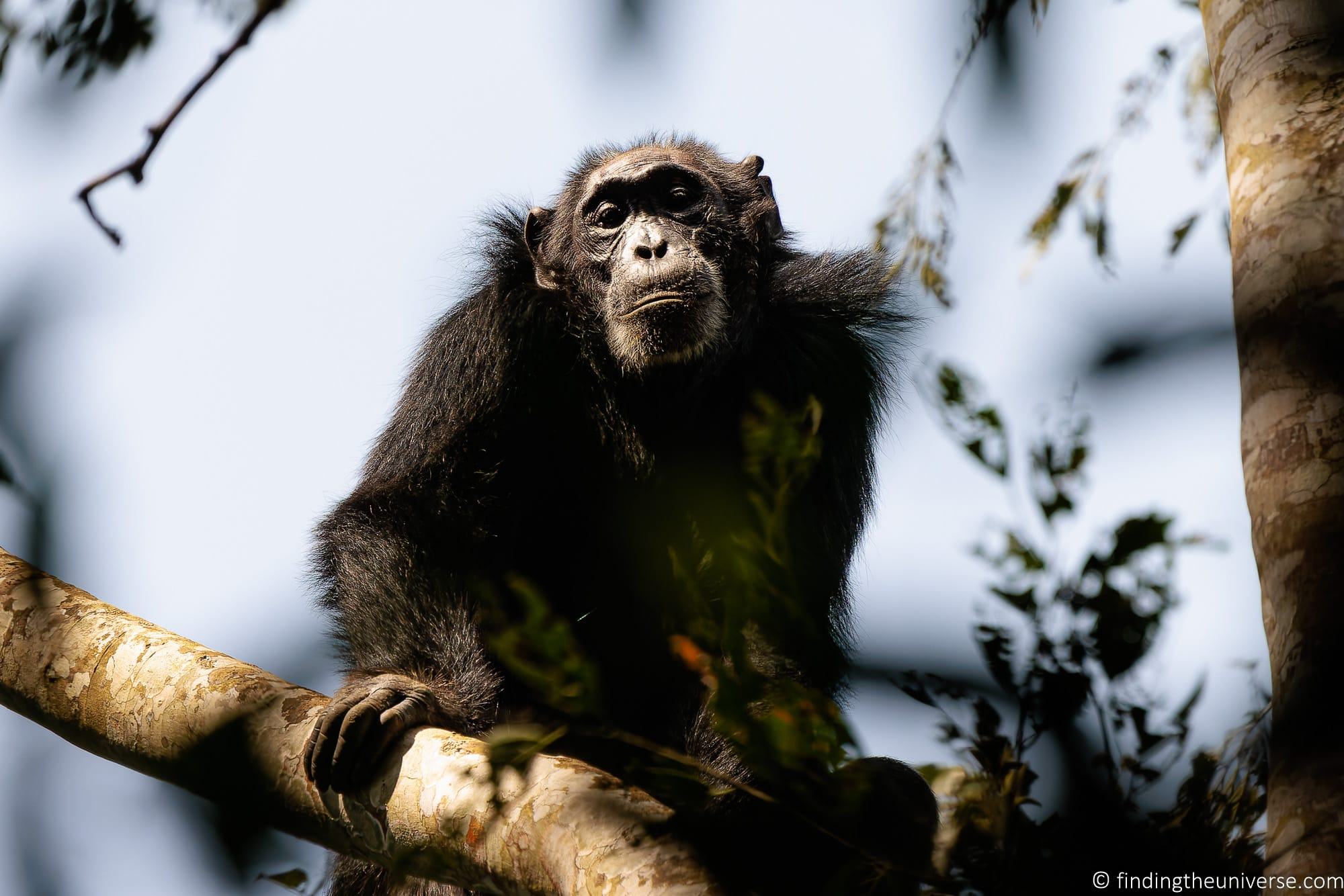
Tips for Photographing Chimpanzees
As a professional travel photographer I wanted to share some tips to help you get the best results when photographing chimpanzees in the wild.
If you are thinking about buying a new camera for your chimpanzee trekking, see my guide to the best safari camera for some tips and suggestions. I also have a guide to getting better photos on safari.
- Disable your flash. You are going to want to take a lot of photos of the chimpanzees, and the forest can be a dark place. Many cameras will automatically enable their flash, which is not allowed. You can read more about disabling your camera flash here.
- Understand ISO and Shutter Speed. When you find the chimpanzees, there’s a good chance they are going to be somewhere fairly dark. Even on a sunny day the jungle canopy cuts out a lot of light. In these situations you will find yourself needing to juggle a high ISO against a suitable shutter speed so you still get sharp images. If you’d like to know more about these controls, see my guide to the exposure triangle in photography
- Consider a zoom lens. Whilst the chimpanzees do sometimes come down from the canopy, this is by no means a guarantee. As such, you might need to photograph them from ground level whilst they are high up in the trees. In these situations, a zoom lens of at least 10x optical zoom, or 400mm on an interchangeable lens camera, would be my recommendation.
- Consider a monopod. If you have a heavy camera and lens, then a monopod will come in very handy especially if the chimpanzees are above you in the trees. Holding a heavy camera to your eye whilst pointing it up into the sky gets tiring very quickly, and a monopod can relieve the strain so you don’t miss a shot. A monopod is a good lightweight alternative to a travel tripod. I travel with a Vanguard VEO tripod that converts into a monopod, giving me the best of both worlds.
- Relax a little. When you first arrive at the chimpanzees you are likely going to be quite excited and start pounding on your shutter button. Whilst this excitement is to be expected, you can probably relax a bit. The chimpanzees are unlikely to run away, and if you take a moment or two to compose yourself you will be able to ensure your camera settings and composition are good before you start capturing the moment.
- Get down to their level. Wildlife photos nearly always look better when you are shooting at eye level rather than down to the animal. This might require you to get yourself lower down (watch out for biting insects and undergrowth of course), but should result in better images. Of course, this is only an option if the chimpanzees come down to the ground.
- Try to make eye contact. I personally find that wildlife images where the subject is making eye contact with the camera are more interesting to look at. Whilst you can’t control where the chimpanzee is looking, you can improve your chances by shooting in burst mode and taking sequences of photos, as the chimpanzee might make fleeting eye contact when you are shooting. Don’t do anything to try and make the chimpanzee look at you though such as making noises, as this might upset them and is against the rules.
- Experiment with wide and close up shots. If you have a zoom lens, it can be tempting to zoom right in on a single chimpanzee subject, to the exclusion of everything else. Whilst this will often make for a striking image, don’t forget to include some wide angle shots we well. This will help to show the scenery and set some context for the viewer. It can also tell more of a story.
- Photograph more than the chimpanzees. Whilst you will obviously want to take a lot of photos of the chimpanzees, your experience is going to include a lot more than the time you spend with them. Hiking through the forest is a unique experience as well, and you will likely come across numerous photography opportunities on your way to and from the chimpanzees that you will want to record!
- Consider improving your photography skills. If you aren’t sure about your photography skills and want to hone then, consider taking a photo course like mine, a local workshop, or similar, to ensure you are going to be able to get the best photos with your equipment.
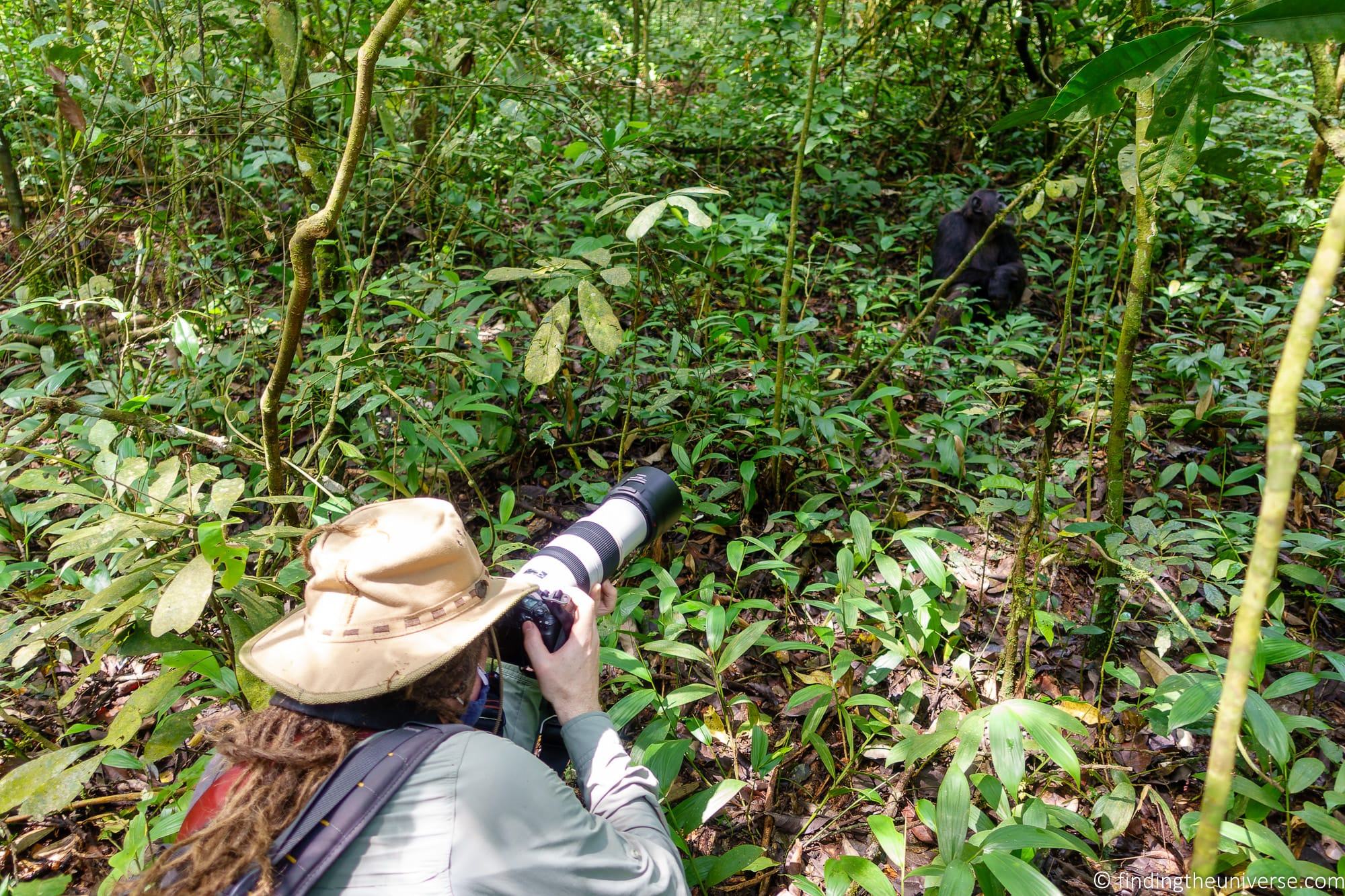
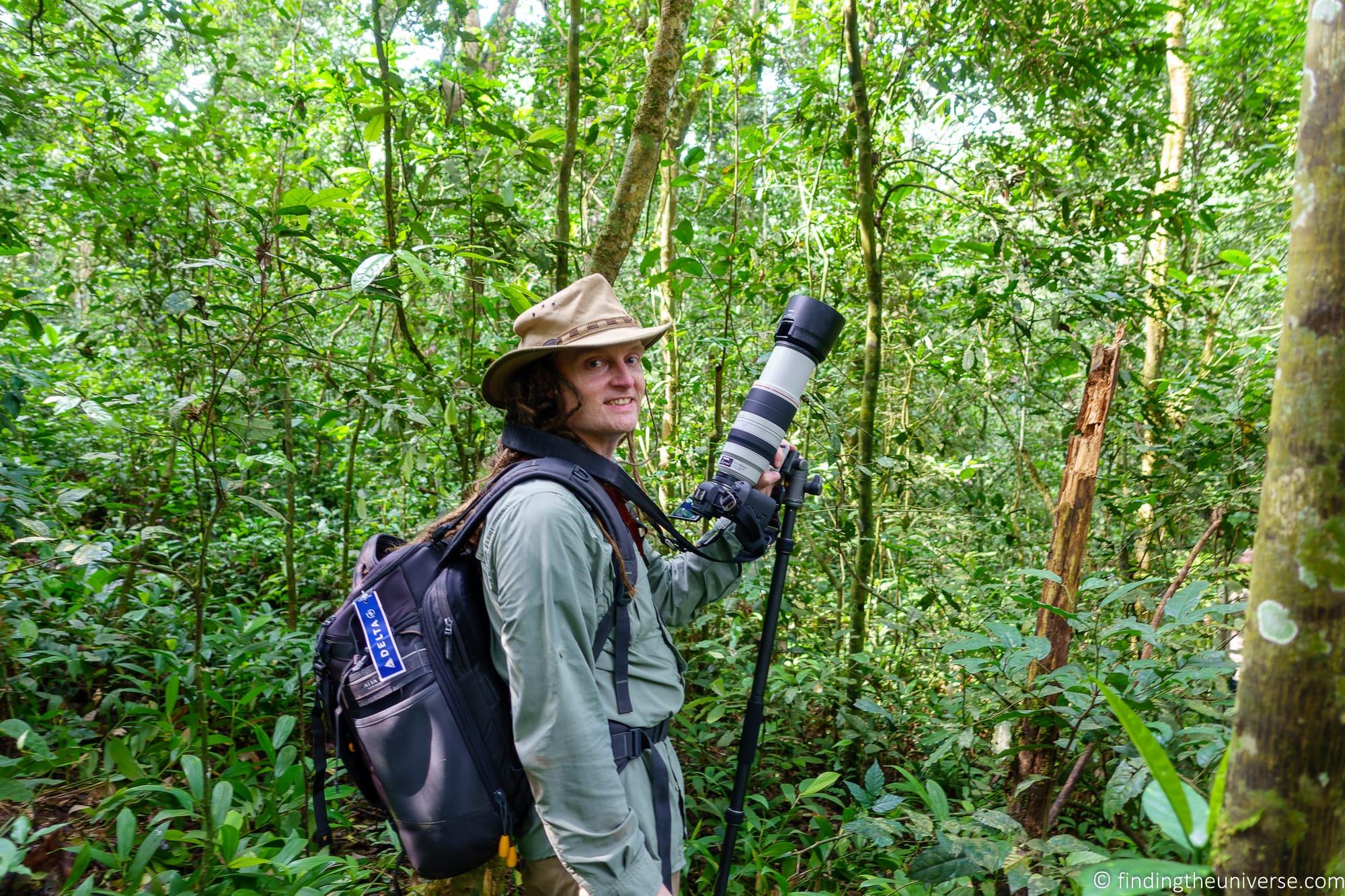
Chimpanzee Trekking Tours in Uganda
Many visitors to Uganda have chimpanzee trekking included as part of their overall tour package as it is one of the more popular activities in the country. We wanted to share some tours in the country which include chimpanzee trekking to give you an idea of what is available.
- This 2 day tour from Kampala takes you to Queen Elizabeth National Park includes chimpanzee trekking in Kyamburu Gorge. Note this tour involves a lot of driving, but is a good way to see chimpanzees if you have limited time.
- This 3-day tour from Kamapala or Entebbe focuses on Murchison Falls National Park, with the option to go chimpanzee trekking for an additional cost.
- This 3-day tour from Kampala includes chimpanzee trekking in Kibale as well as time exploring Queen Elizabeth National Park.
- This 4-day tour from Kampala includes chimpanzee trekking in Kibale, safari in Queen Elizabeth and gorilla trekking in Bwindi.
- This 4-day tour from Entebbe includes chimpanzee trekking in Kibale forest, as well as rafting on the Nile river.
- This 5-day luxury tour from Entebbe includes both chimpanzee trekking in Kibale and gorilla trekking in Bwindi
- This 5-day tour offers departures from multiple locations. It includes a chimpanzee habituation experience in Kibale, as well as hot air ballooning in Murchison Falls.
- This 7-day tour from Entebbe or Kampala includes gorilla trekking in Bwindi, chimpanzee trekking in Kibale, tree climbing lions in Queen Elizabeth and lots more
- This 8-day tour from Entebbe has both gorilla trekking in Bwindi and chimpanzee trekking in Kibale, as well as a number of other safari activities.
- This 9-day tour for 18-39 year olds from Kampala includes gorilla trekking in Bwindi and chimpanzee trekking in Kalinzu Forest Reserve, as well as a number of other locations in Uganda.
- This 10-day tour from Entebbe covers many of the highlights of Uganda, including seeing the Big Five. It also includes gorilla trekking in Bwindi and chimpanzee trekking in Kibale. A good option if you want to see more of what Uganda has to offer.
- This 16-day tour from Nairobi has you spending time in Kenya, Uganda and Rwanda. It includes chimpanzee trekking in Kibale and gorilla trekking in Bwindi.
This should give you an idea of what is available. You can see more tours which include chimpanzee trekking on GetYourGuide here, Viator here and G Adventures here.
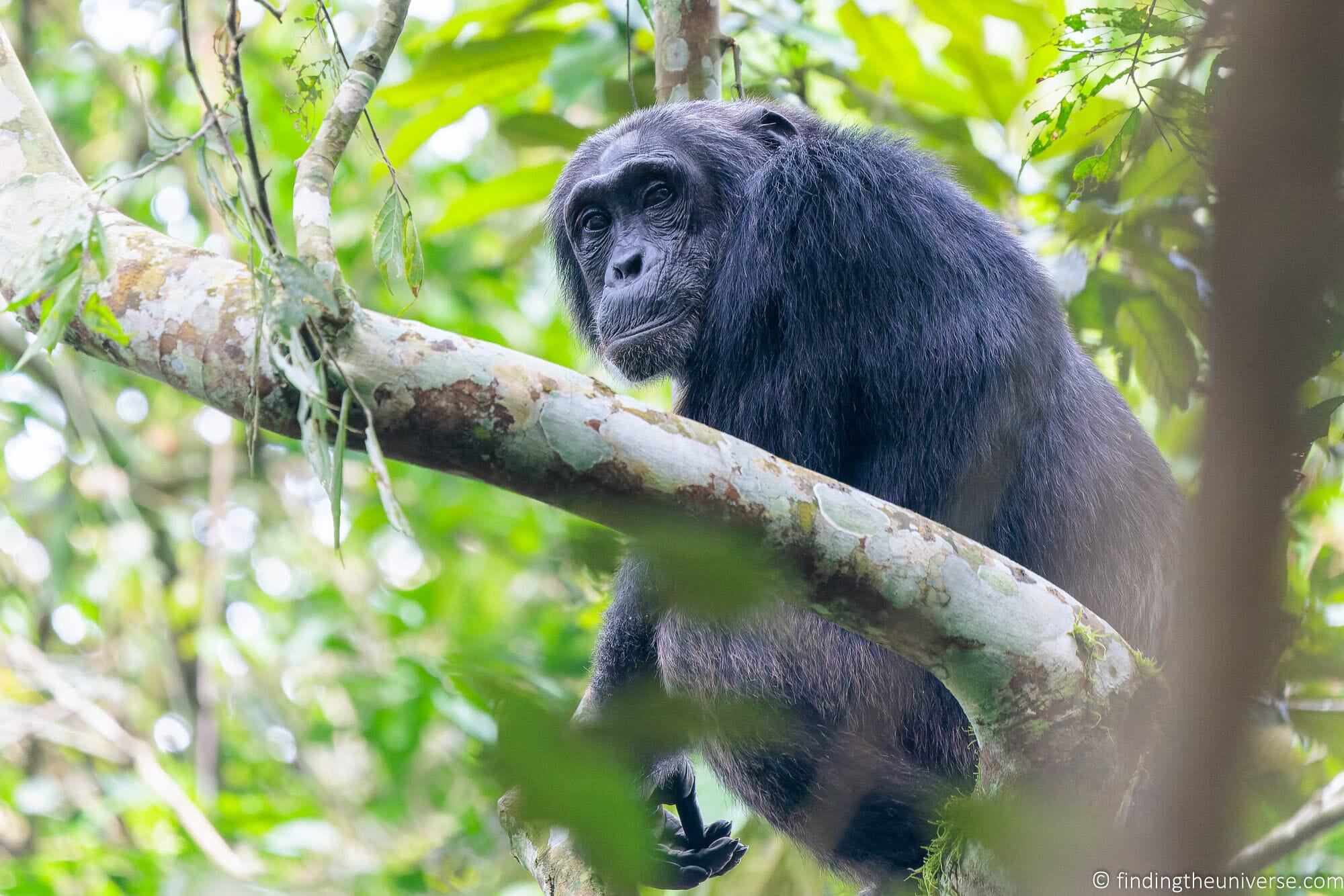
Further Reading
That sums up our guide to chimpanzee trekking in Uganda. We hope you found it useful! Before you head off, we wanted to share some links to other content we think you might find useful in planning your trip to Uganda and the wider region.
And that’s it! As always, we hope you found this guide useful. If you have any questions or comments, just pop them in the comments section below and we’ll get back to you as soon as we can.
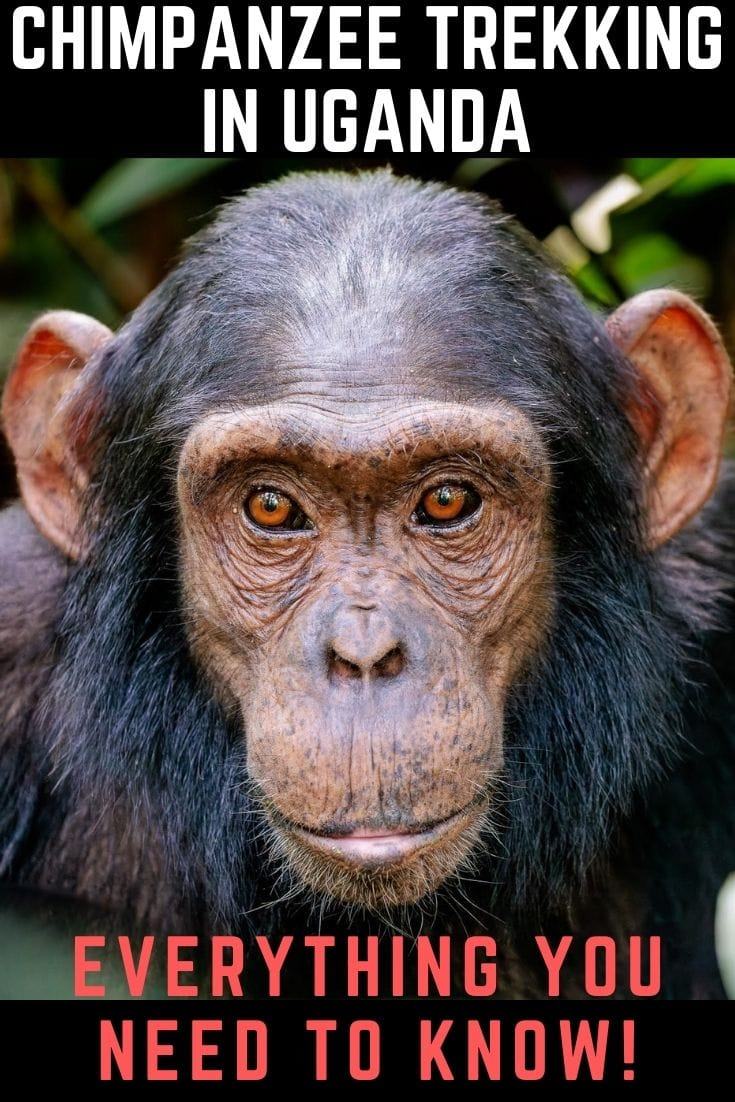
[ad_2]
Source link
